- Home
- About
- Map
- Trips
- Bringing Boat West
- Migration West
- Solo Motorcycle Ride
- Final Family XC Trip
- Colorado Rockies
- Graduates' XC Trip
- Yosemite & Nevada
- Colorado & Utah
- Best of Utah
- Southern Loop
- Pacific Northwest
- Northern Loop
- Los Angeles to NYC
- East Coast Trips
- Martha's Vineyard
- 1 Week in Quebec
- Southeast Coast
- NH Backpacking
- Martha's Vineyard
- Canadian Maritimes
- Ocracoke Island
- Edisto Island
- First Landing '02
- Hunting Island '02
- Stowe in Winter
- Hunting Island '01
- Lake Placid
- Chesapeake
- Provincetown
- Hunting Island '00
- Acadia in Winter
- Boston Suburbs
- Niagara Falls
- First Landing '99
- Cape Hatteras
- West Coast Trips
- Burning Man
- Utah Off-Roading
- Maui
- Mojave 4WD Course
- Colorado River Rafting
- Bishop & Death Valley
- Kauai
- Yosemite Fall
- Utah Off-Road
- Lost Coast
- Yosemite Valley
- Arizona and New Mexico
- Pescadero & Capitola
- Bishop & Death Valley
- San Diego, Anza Borrego, Joshua Tree
- Carmel
- Death Valley in Fall
- Yosemite in the Fall
- Pacific Northwest
- Utah Off-Roading
- Southern CA Deserts
- Yosemite & Covid
- Lake Powell Covid
- Eastern Sierra & Covid
- Bishop & Death Valley
- Central & SE Oregon
- Mojave Road
- Eastern Sierra
- Trinity Alps
- Tuolumne Meadows
- Lake Powell Boating
- Eastern Sierra
- Yosemite Winter
- Hawaii
- 4WD Eastern Sierra
- 4WD Death Valley +
- Southern CA Deserts
- Christmas in Tahoe
- Yosemite & Pinnacles
- Totality
- Yosemite & Sierra
- Yosemite Christmas
- Yosemite, San Diego
- Yosemite & North CA
- Seattle to Sierra
- Southwest Deserts
- Yosemite & Sierra
- Pacific Northwest
- Yosemite & South CA
- Pacific Northwest
- Northern California
- Southern Alaska
- Vancouver Island
- International Trips
- Index
- Tips
- Books
- Photos/Videos
- Search
- Contact
Camping La Marina
Friday, May 24, 2019 - 6:00pm by Lolo260 miles and 4.5 hours from our last stop - 3 night stay
Travelogue
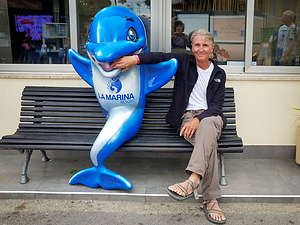 We arrive at Camping La MarinaAlthough I do most of the trip planning, I always put Herb in charge of selecting ones along a beach, as he is definitely the beach aficionado in the family. Our plan was to ws continue meandering down the Mediterranean Coast and camp somewhere on a nice beach in striking distance to Grenada, where we had tickets for a guided tour of the Alhambra on the following Tuesday.
We arrive at Camping La MarinaAlthough I do most of the trip planning, I always put Herb in charge of selecting ones along a beach, as he is definitely the beach aficionado in the family. Our plan was to ws continue meandering down the Mediterranean Coast and camp somewhere on a nice beach in striking distance to Grenada, where we had tickets for a guided tour of the Alhambra on the following Tuesday.
That criteria brought us to Camping La Marina, picked by Trip Advisor as the best campground on the Costa Blanca. The campground (more like a theme park) has facilities way beyond anything we have ever encountered at a campground in the U.S.
There is an Aquamarine Park with ten spectacular water slides, a play area with a giant tipping buckets that periodically dumps gallons of water on heads below, and a theme pool surrounded by tropical plants and a jacuzzi.
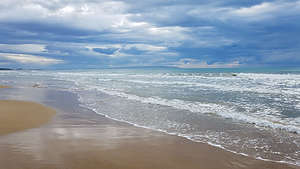 La Marina BeachIn addition to the water park, there is a lovely restaurant specializing in paella overlooking the pool, an extremely well-equipped fitness center and spa, a very well-stocked supermarket (with fresh bread every morning), an outdoor cafe serving ice cream and coffee, and more.
La Marina BeachIn addition to the water park, there is a lovely restaurant specializing in paella overlooking the pool, an extremely well-equipped fitness center and spa, a very well-stocked supermarket (with fresh bread every morning), an outdoor cafe serving ice cream and coffee, and more.
The pitches are pretty spacious by European standards and separated by hedges to provide some degree of privacy, and while not directly on the water, it is just a 10-minute walk along a boardwalk through a forest to a lovely sandy beach. Just a short walk to the right is the Playa Els Tossals, another one of Spain’s popular naturist beaches.
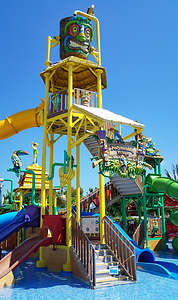 La Marina Aquamarine ParkUnfortunately, our La Marina stop overlapped a weekend, so the campground was very crowded with families and kids who were still in school. It pretty much cleared out Sunday night.
La Marina Aquamarine ParkUnfortunately, our La Marina stop overlapped a weekend, so the campground was very crowded with families and kids who were still in school. It pretty much cleared out Sunday night.
Unlike U.S. campgrounds where the quiet hours start at 10 pm, here in Spain, where people never seem to go to sleep, quiet time didn’t start until midnight, and kids took advantage of every last minute, riding bikes, kicking soccer balls, playing tag, etc. right up until the clock struck 12.
Our first day at La Marina was pretty overcast and windy, so we spent the morning running on a treadmill in the fitness center followed by my first paella in the upscale campground restaurant.
Although it was a bit too chilly and windy to just hang out on the beach, we took an afternoon walk along the Playa Els Tossals to the jetty where the Segur River flows into the Mediterranean. We also got our first sighting of Africa, just above the horizon.
The next morning we awoke to sunny skies, so we made our commute along the boardwalk to the Playa Els Tossals and spent the day sunning and swimming in the Mediterranean. It was very relaxing - good thing, because the pace of the trip was going to pick up from here.
Description
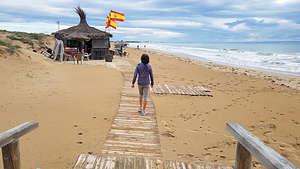 Beach by La MarinaBeautiful campground in Alicante, picked by Trip Advisor as the best campground on the Costa Blanca. The campground (more like a theme park) has facilities way beyond anything we have ever encountered at a campground in the U.S.
Beach by La MarinaBeautiful campground in Alicante, picked by Trip Advisor as the best campground on the Costa Blanca. The campground (more like a theme park) has facilities way beyond anything we have ever encountered at a campground in the U.S.
There is an Aquamarine Park with ten spectacular water slides, a play area with a giant tipping buckets that periodically dumps gallons of water on heads below, and a theme pool surrounded by tropical plants and a jacuzzi.
In addition to the water park, there is a lovely restaurant specializing in paella overlooking the pool, an extremely well-equipped fitness center and spa, a very well-stocked supermarket (with fresh bread every morning), an outdoor cafe serving ice cream and coffee, and more.
The pitches are pretty spacious by European standards and separated by hedges to provide some degree of privacy, and while not directly on the water, it is just a 10-minute walk along a boardwalk through a forest to a lovely sandy beach. Just a short walk to the right is the Playa Els Tossals, another one of Spain’s popular naturist beaches.
Camping Cala D'Oques
Thursday, May 23, 2019 - 5:30pm by Lolo15 miles and 0.5 hours from our last stop - 1 night stay
Travelogue
 First night camping at Cala D'OquesWe thought that after the rush of picking up the van and stocking it, it would be nice to just chill on a beach for the first two nights.
First night camping at Cala D'OquesWe thought that after the rush of picking up the van and stocking it, it would be nice to just chill on a beach for the first two nights.
Herb had done some research and found a lovely little campground called Camping Cala D’Oques located right on the beach along the Costa Daurada (Golden Coast). The whole Mediterranean Coast of Spain from Barcelona to Gibraltar is divided into various Costas - Costa Almeria, Costa Blanca (White Coast), Costa Brava (Rugged Coast), Costa Calida (Warm Coast), Costa del Sol (Sunshine Coast), and so on.
Although we did have a reservation, there wasn’t much space left for us, and it was a bit of a free for all in that sites weren’t assigned. Fortunately, the van was small enough to squeeze into what was the last beachfront spot.
There were some ominous clouds on the horizon, and the forecast wasn’t particularly great, so we quickly got ready to go to the beach before things turned.
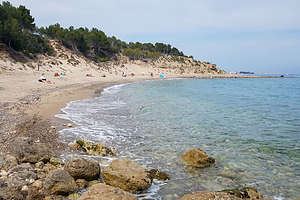 Platja del TornWhile getting stuff out of the front seat of the van, I somehow managed to closed the door on my fingers. Three of them, up to my knuckles, were literally stuck in the door, which somehow managed to completely close. Not wanting to make a scene, I sort of quietly yelled to Herb that I needed help. Jumping into action, he ran from the back of the van to the front to open the door, smacking his head into the overhead storage along the way. Once he had set me free, we assessed the damage. He had a pretty good-size goose egg on his forehead, but my fingers were miraculously not broken. However, when I bent them, they started bleeding across my knuckles.
Platja del TornWhile getting stuff out of the front seat of the van, I somehow managed to closed the door on my fingers. Three of them, up to my knuckles, were literally stuck in the door, which somehow managed to completely close. Not wanting to make a scene, I sort of quietly yelled to Herb that I needed help. Jumping into action, he ran from the back of the van to the front to open the door, smacking his head into the overhead storage along the way. Once he had set me free, we assessed the damage. He had a pretty good-size goose egg on his forehead, but my fingers were miraculously not broken. However, when I bent them, they started bleeding across my knuckles.
I hoped that none of the other campers saw the crazy Americans settling in. We took a few minutes to collect ourselves and tape up my hand before heading out to the beach.
From our campsite we walked along a beach path to the Platja del Torn, a 3 km long, lovely, dark sand beach set against the dunes. Beaches are called “platjas” in Catalonia as opposed to “playas” in the rest of Spain. It is also Catalonia’s most popular naturist beach. Naturism is much more common and accepted in Spain, so on most beaches you will find a variety of attire (or lack of), from nudity to topless, to bathing suits. Everyone seems very comfortable with the concept.
Herb fell asleep almost immediately so he missed my first entry into the Mediterranean, which was probably good, because my hopping and whooping along the hot, dark sand to get to the water was not the most graceful.
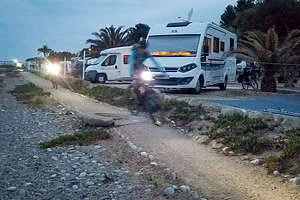 Night time mountain bikers whizzing past our campsiteThe whole time we were at the beach, dozens of mountain bikers came speeding down the hill behind us. We figured we must be along a popular mountain biking route. Even later that evening after dark - which in Spain in the summer is after 10:00 pm, mountain bikers with headlamps sped by our campsite along the beach path. What we were to learn over the next few weeks is that biking is extremely popular in Spain - they were everywhere.
Night time mountain bikers whizzing past our campsiteThe whole time we were at the beach, dozens of mountain bikers came speeding down the hill behind us. We figured we must be along a popular mountain biking route. Even later that evening after dark - which in Spain in the summer is after 10:00 pm, mountain bikers with headlamps sped by our campsite along the beach path. What we were to learn over the next few weeks is that biking is extremely popular in Spain - they were everywhere.
The next morning, we woke up to rain and a pretty bleak forecast for the whole day. However, things looked better further south, so we decided to shift down a “Costa” or two and arrive a day early at our next campground - Camping La Marina, in Alicante on the Costa Blanca.
Too bad, because this campground and beach would have been pretty phenomenal on a sunny day.
McRent RV Rental
Thursday, May 23, 2019 - 10:00am by Lolo0 miles and 0 hours from our last stop
Travelogue
 First night camping at Cala d'OquesHaving gained experience two years ago with driving a camper van in Europe, we were much more knowledgeable about what to expect in terms of roads (they can get pretty narrow!) and the size of campsites to squeeze into. As a result, we wanted to go no bigger than the 6-meter van we had rented before. Although much less spacious than our Lazy Daze, it was comfortable enough and much less stressful to drive around a strange country.
First night camping at Cala d'OquesHaving gained experience two years ago with driving a camper van in Europe, we were much more knowledgeable about what to expect in terms of roads (they can get pretty narrow!) and the size of campsites to squeeze into. As a result, we wanted to go no bigger than the 6-meter van we had rented before. Although much less spacious than our Lazy Daze, it was comfortable enough and much less stressful to drive around a strange country.
We started the search and completed the booking process about 4 months ahead of our trip. We knew exactly what we wanted - a 6-meter long Urban Plus from McRent - just like we had in Munich. It was the perfect van for us - very efficiently designed with a big queen-size bed across the back, bathroom with shower, dinette, refrigerator and stove, and lots of storage space. Not cheap though. It cost us $2,833 for 25 days, which works out to about $113 a day.
Unfortunately, McRent’s Barcelona facility only has larger campers, but Herb was able to find the one we wanted at their facility in Tarragona (just an hour south of Barcelona by train).
So, after four wonderful nights in Barcelona, we took a taxi to the Barcelona Sants train station and from there it was only a little over an hour to Tarragona (8 € apiece). Trains are wonderful in Europe - on time, fast, clean, comfortable, and inexpensive.
One little glitch getting to McRent. Google Maps directed our taxi driver to an empty lot, which according to Google was McRent. We all sort of stared at each other blankly wondering what to do next. Although our driver spoke zero English, we were able to get the point across, and he was kind enough to call the McRent number and speak in Spanish to the receptionist, who gave us a different address for a place called Carvisa, that acts as McRent’s depot in Tarragona.
Things got a lot smoother from there. The people in the Carvisa office were great, and knew enough English to explain the details of the vehicle, which went fairly quickly because Herb was already familiar with the it.
Not wanting to stress about finding a place to sleep on our first night in the camper, we had booked in advance a campsite at Camping Cala D’Oques, right on the beach along the Costa Daurada, less than a half hour from Carvisa.
 First Spanish superm ercado after picking up vanHowever, our first order of business upon hitting the road was stocking up the motorhome, so we stopped at a Mercadona, a supermarket chain in Spain that we came to love. Food shopping in a foreign country is always a bit challenging at first, but besides the different brand names, it was quite similar in quality and variety to our own - except there was a lot more jamon!!.
First Spanish superm ercado after picking up vanHowever, our first order of business upon hitting the road was stocking up the motorhome, so we stopped at a Mercadona, a supermarket chain in Spain that we came to love. Food shopping in a foreign country is always a bit challenging at first, but besides the different brand names, it was quite similar in quality and variety to our own - except there was a lot more jamon!!.
Herb did have a little problem selecting coffee, as the van only had a mocha pot rather than the drip type we were used to. He had taken a picture of it on his phone and stood looking at it somewhat pathetically in front of the coffee selection, until a woman took pity on him and pointed to what he wanted.
Wine was amazingly cheap - you can get a good bottle of white for 3 to 5 €. Beer was reasonable too, except for Lagunitas, an American brand which ironically is brewed right by our house. One bottle cost 3 €, which is practically the price of a six-pack in Spain.
Breakfast and lunch items were fairly easy, but cooking dinner in the camper is a bit tougher, since there is only a 2-burner stove - no microwave or oven like I am used to in our Lazy Daze. Besides, campgrounds in Spain have restaurants, so I wasn’t planning on having too many dinners in the camper. However, for those times we would, we bought salad ingredients, bratwurst, and tortellinis as easy to make dinners.
Amazingly the camper refrigerator fit everything quite nicely - very efficient design - and there was plenty of storage for the non-perishables.
Now, onto the vacation part.
Description
A motorhome rental service operating throughout Europe that offers all kinds of motorhomes. In fact, it is Europe's largest motorhome rental company.
Here is a link to their fleet, which ranges from small camper vans to larger Class C and Class A RVs: https://www.mcrent.eu/motorhome-rv/
You can currently find McRent motorhome rental in Germany, the Netherlands, Spain, France, Portugal, Italy, Switzerland, Norway, Sweden, Finland, Great Britain, Ireland, Estonia, Poland and Iceland.
Barcelona
Sunday, May 19, 2019 - 1:30pm by Lolo0 miles and 0 hours from our last stop - 4 night stay
Travelogue
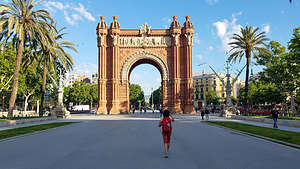 Arc de Triomf de BarcelonaIt didn’t take us too long during our trip planning to pick Barcelona as our base city before venturing out in our camper van to tour the country. We decided that we would stay four nights as that would give us three full days to cover a lot of ground.
Arc de Triomf de BarcelonaIt didn’t take us too long during our trip planning to pick Barcelona as our base city before venturing out in our camper van to tour the country. We decided that we would stay four nights as that would give us three full days to cover a lot of ground.
Location, location, location is the most important criteria we consider in selecting a hotel, without paying too much, so it was a pretty easy choice to book our stay at Motel One located across the street from the lovely Parc de la Ciutadella, and in easy walking distance to the Gothic Quarter and Las Ramblas.
We landed in Barcelona 4:45 in the afternoon after a 13 hour direct flight from San Francisco. From the airport it was an easy transport on the Aerobus shuttle to the Placa de Catalunya, which was less than a mile from our hotel. Somewhat foolishly, rather than call a cab, we decided to walk it, which wouldn’t have been too bad if we had had some sleep in the last 24 hours and didn’t have our luggage to carry -- although I must say that our luggage wasn’t as bad as it could have been if Herb hadn’t restricted me to one carry-on bag.
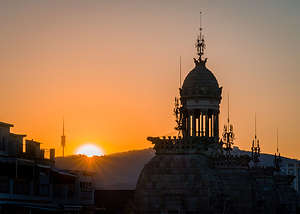 View from Motel One rooftop barWe were quite pleased when we arrived at our hotel. We already knew that the location was great, but the atmosphere of the hotel was awesome as well - beautiful, bright lobby, nice big dining room where a breakfast buffet is served every morning, rooftop bar overlooking the city, and a comfy (yet a bit small) room. Plus, the price was right considering its excellent location - about 130 € per night.
View from Motel One rooftop barWe were quite pleased when we arrived at our hotel. We already knew that the location was great, but the atmosphere of the hotel was awesome as well - beautiful, bright lobby, nice big dining room where a breakfast buffet is served every morning, rooftop bar overlooking the city, and a comfy (yet a bit small) room. Plus, the price was right considering its excellent location - about 130 € per night.
We were pretty exhausted, so we took a quick nap, but not too long because we wanted to be able to fall asleep at Spain bedtime (which actually is like 3:00 am) and get in synch with the local time as soon as possible.
Herb looked at Trip Advisor and found a highly rated pizza place called La Mezcla, less than a half a mile from our hotel.
It was the perfect choice for two tired old tourists on their first night in Barcelona.
Day 1 - Las Ramblas, Gothic Quarter, Barceloneta, and Montjuic
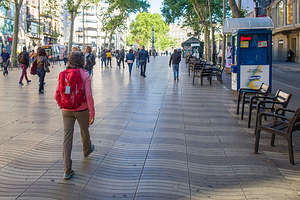 Lolo strolling along the wavy tile work of Las RamblasWe both slept quite well considering it was our first night and were ready for a big day touring the city. I kiddingly said we should walk 20 miles today, words I would later regret.
Lolo strolling along the wavy tile work of Las RamblasWe both slept quite well considering it was our first night and were ready for a big day touring the city. I kiddingly said we should walk 20 miles today, words I would later regret.
When we booked our room, we did not opt for the breakfast, which was an extra 9 € per person. However, when we saw the spread laid out, we changed our mind. There was fruit, eggs, Muesli, breads, cheeses, jamon (of course), croissants filled with various goodies including chocolate, and on and on. Herb easily ate 30 € worth.
We definitely needed to walk that off, so off we went, starting our day with a stroll along Las Ramblas, Barcelona’s most famous pedestrian mall. It begins at the Placa de Catalunya (where we arrived from the airport yesterday) and ends at the waterfront, a little over a mile away.
It used to be a place where locals hung out, but unfortunately, it has now been taken over by tacky souvenir shops, so-so restaurants, pickpockets (mostly at night), and hordes of tourists, stripping it of much of its charm. Still, it is a very nice walk, especially in the morning when it is quieter, with many interesting sights along the way, such as:
- Fountain of Canaletes - ornate black and gold lamp post with a fountain at its base. Legend says that a drink from it ensures you will return to Barcelona one day
- Wavy tile work - represents the stream that once flowed here
- Chairs fixed to the sidewalk at jaunty angles
- Betlem Church - 17th century Baroque church with sloping roofline, ball-topped pinnacles, corkscrew columns
- Rambla of Flowers - flower stands
- La Boqueria Market - Barcelona’s iconic produce market, with a maze of stalls selling fruits and veggies, fish and seafood, meats and mushrooms, and spices and candy
- Plaça de la Boqueria - here you will see the Joan Miro mosaic in red, white, yellow, and blue
- Plaça Reial - dotted with palm trees and surrounded by yellow buildings with white trim this placa has old-fashioned taverns as well as modern bars with patio seating
- Palau Guell - apartment building designed by Antoni Gaudi. This was the first of his Modernista buildings, and you can see his emerging nonlinear style in the arches and doorways
- Christopher Columbus monument
- Rambla del Mar - wavy wooden walkway along the waterfront
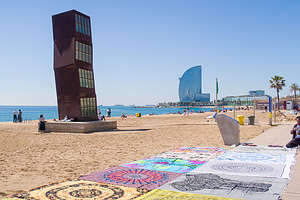 La Estrella Herida and vendor wares along Barceloneta BeachOnce we got to the waterfront, we headed north along the city’s lovely man-made beach, which extends for several miles, with many seafood restaurants and bars along the way.
La Estrella Herida and vendor wares along Barceloneta BeachOnce we got to the waterfront, we headed north along the city’s lovely man-made beach, which extends for several miles, with many seafood restaurants and bars along the way.
Despite the signs warning no street vendors allowed, the entire promenade was lined with people selling their wares. I loved watching them meticulously, and obviously with a great deal of pride, set up their items in the most appealing manner possible. For example, those selling shoes placed one shoe down, and the other on a diagonal across the first. And they did this for 30+ pairs of shoes.
The item I was most tempted to buy was one of the large beach blankets with intricate patterns on it. Some looked like oriental rugs. Others had elephants (like the kind you find on Thai elephant pants). However, by allowing me only a carry-on bag, Herb had pretty much cut off any possibility of shopping, as my bag could not even have fit another pair of underwear in it. Very clever of him.
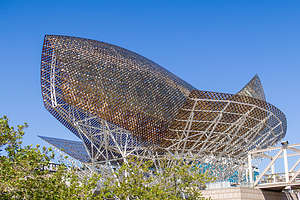 Frank Gehry's Peix (Fish)Of course, you can’t go too far in Barcelona without encountering contemporary art, so it wasn’t long before we came upon La Estrella Herida, a 33-foot beach sculpture of four stacked leaning steel cubes, with windows, by the artist Rebecca Horn.
Frank Gehry's Peix (Fish)Of course, you can’t go too far in Barcelona without encountering contemporary art, so it wasn’t long before we came upon La Estrella Herida, a 33-foot beach sculpture of four stacked leaning steel cubes, with windows, by the artist Rebecca Horn.
Continuing our beach promenade, in less than a mile we met Frank Gehry’s Peix, a 56 meter long and 35 meter high golden fish, built for the 1992 Barcelona Olympics. It’s constructed of intertwining gilded golden steel strips and is held together by a metal structure. Its shiny gold surface, which gives the appearance of fish scales, changes appearance depending on the weather and the angle of the sun.
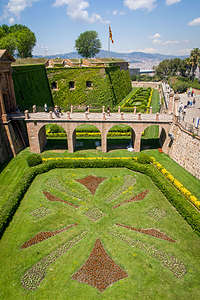 Montjuic CastleAfter the fish, we turned around and retraced our steps along the Barceloneta with the intention of taking the cable car up to Montjuic. During the entire walk south along the Barceloneta, the famous W Hotel loomed over the beach. Even the hotels in Barcelona are artistic masterpieces. This one, which was designed by Ricardo Bofill, is in the shape of a sail, very appropriate for its location on the sea. It’s huge, and I am sure much more expensive than our humble abode at Motel One.
Montjuic CastleAfter the fish, we turned around and retraced our steps along the Barceloneta with the intention of taking the cable car up to Montjuic. During the entire walk south along the Barceloneta, the famous W Hotel loomed over the beach. Even the hotels in Barcelona are artistic masterpieces. This one, which was designed by Ricardo Bofill, is in the shape of a sail, very appropriate for its location on the sea. It’s huge, and I am sure much more expensive than our humble abode at Motel One.
We continued on to Transbordador Aeri del Port, where we had planned to be whisked in style to the top of Montjuic. However, the line was long and about an hour wait, so we decided to just walk to the top instead. After all, it was only 3 miles. What we didn’t factor in was that it was mostly uphill, it was hot, and we were hungry, and there were no restaurants along our route. I confess to getting a wee bit cranky.
Halfway up the mountain, we stopped on a bench near a fancy hotel, so I could whine for a bit and eat a Cliff Bar that I found at the bottom of my pack. Why wasn’t Herb suffering as much as me, which made me even crankier.
 View of the Port of Barcelona from MontjuicFinally, we got to the Montjuic Castle on top, which did have great views of the city and the port. We also went inside for a tour where we learned that this 17th century fortress has had rather a dark history of being used as a political prison and killing ground. Well, that was a real mood picker upper.
View of the Port of Barcelona from MontjuicFinally, we got to the Montjuic Castle on top, which did have great views of the city and the port. We also went inside for a tour where we learned that this 17th century fortress has had rather a dark history of being used as a political prison and killing ground. Well, that was a real mood picker upper.
We walked back down the mountain towards our hotel, but I wasn’t done yet. I still wanted to see the Gothic Quarter, which we had to walk through anyway to get back home.
I had Herb key in a few key stops on my list of things to see there, but with the narrow alleyways, our GPS just wasn’t working. We couldn’t even find the Barcelona Cathedral. In retrospect, it would have been much better to have had a physical map, because Google Maps won’t help you when satellites are blocked. It was very frustrating.
We decided to go back to the hotel for a nap and then go out again for another go at the historic Gothic quarter, where Rick Steves suggested we should lose ourselves along its old Medieval cobblestone lanes. I had written down some interesting things that he suggested seeing.
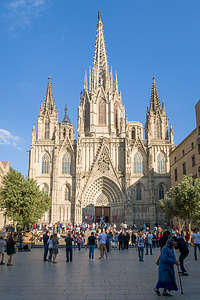 Barcelona CathedralOne of the main things I wanted to do was to see the Barcelona Cathedral. Just to make sure, I checked the website to confirm that entry for tourists was until 7:15, as worship services started at 7:45.
Barcelona CathedralOne of the main things I wanted to do was to see the Barcelona Cathedral. Just to make sure, I checked the website to confirm that entry for tourists was until 7:15, as worship services started at 7:45.
We found it quite easily this time - not sure how we missed it before, but when we approached the church to enter it at 6:45, we were turned away and I have no idea why as the explanation was in Basque. Still, the exterior of the church is absolutely breathtaking, so we satisfied ourselves with that. It was built in the 14th century in the Gothic Flamboyant (“flame-like”), style, characterized by pointed arches and spires, and stained glass windows elaborate “flame-like” tracery.
Herb had been much more fortunate on a visit here over 30 years ago, as he got to see Barceloneans joining together for a Sardana dance, where they link hands and dance in a circle. This dance is performed on Sundays at 11:15 and many Saturdays at 18:00.
Adjacent to the Cathedral is the Casa del Ardiaca , an old mansion that now functions as the city archives. From the courtyard, we climbed up to the balcony for views of the Barcelona Cathedral steeple and gargoyles.
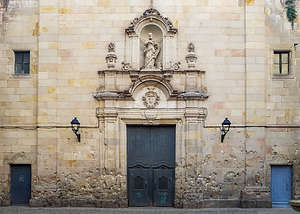 Shrapnel wounds from the Spanish Civil War in the Placa Sant Felip NeriWe continued wandering through the Gothic quarter and eventually stumbled upon the tiny Placa Sant Felip Neri, a small shaded square with a fountain in its center, which is now the playground of an elementary school. However, this place was not always so delightful a place to be. During the Spanish Civil War, in 1938 Franco’s fascists bombarded this area, killing 42 people, mostly children. You can still see the shrapnel wounds in the facade of the old Baroque church, a haunting reminder of this Spain’s horrific past.
Shrapnel wounds from the Spanish Civil War in the Placa Sant Felip NeriWe continued wandering through the Gothic quarter and eventually stumbled upon the tiny Placa Sant Felip Neri, a small shaded square with a fountain in its center, which is now the playground of an elementary school. However, this place was not always so delightful a place to be. During the Spanish Civil War, in 1938 Franco’s fascists bombarded this area, killing 42 people, mostly children. You can still see the shrapnel wounds in the facade of the old Baroque church, a haunting reminder of this Spain’s horrific past.
Although infinitely more peaceful than during the horror of the Civil War, there is still much political unrest in Barcelona, as the Catalonians continue to seek their independence from the rest of Spain. “Free are political prisoners” is painted on many walls throughout the city and the Catalonian separatist flag, La Estelada hangs from many a balcony. So, history forges on.
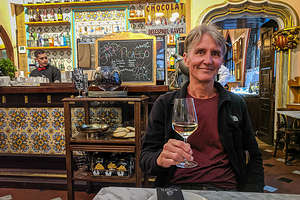 Dinner at Els Quatre Gats, Picasso's old hangoutIn addition to being able to take a journey through Barelona’s Medieval and Spanish Civil War past, there are also Roman ruins dating back to when the Romans founded the town of Barcino in 12 BC. The Playa Nova is flanked by two Roman towers that once guarded the entrance to the city and there are ruins of an ancient Roman Temple of Augustus. Unfortunately, it was closed for restoration.
Dinner at Els Quatre Gats, Picasso's old hangoutIn addition to being able to take a journey through Barelona’s Medieval and Spanish Civil War past, there are also Roman ruins dating back to when the Romans founded the town of Barcino in 12 BC. The Playa Nova is flanked by two Roman towers that once guarded the entrance to the city and there are ruins of an ancient Roman Temple of Augustus. Unfortunately, it was closed for restoration.
Amazing how we strolled through millenniums of history in such a small distance.
We ended our very full day with dinner at Els Quatre Gats (or Esl 4Gats), a circe 1900 cafe and restaurant that was once a popular hangout for Picasso and other Modernista artists. It was quite cozy. We sat in the bar section having tapas (salt cod, bravas, mozzarella and sauce) and wine, and talking about all that we had seen that day in our 20 miles of walking around this wonderful city.
Day 2 - Full Gaudi Day
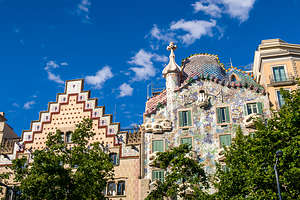 Rooftop of Gaudi's Casa BatlloHappy Gaudi Day! Today, was going to be another full day of walking and exploring, with our goal of seeing as many examples of Gaudi’s works as possible, and, believe me, there are many in Barcelona.
Rooftop of Gaudi's Casa BatlloHappy Gaudi Day! Today, was going to be another full day of walking and exploring, with our goal of seeing as many examples of Gaudi’s works as possible, and, believe me, there are many in Barcelona.
Gaudi and the soccer player Messi are probably the two most popular and well-known names in Barcelona, and rightly so, as they both have done so much to draw attention to this wonderful city.
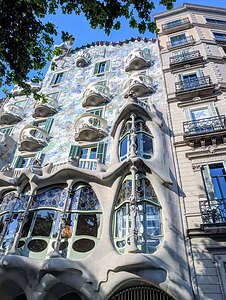 Gaudi's Casa Batllo on the Block of DiscordHowever, Gaudi’s skills were of a different sort. Born in 1852, he studied architecture in Barcelona and went on to a long distinguished career building a number of innovative works throughout the city. He is considered to be the master of Catalan Modernism, a style characterized by asymmetry, the predominance of wavy curves over straight lines, the use of vegetal and other organic motifs, intricate decoration and detail, and brightly colored glass and tile - elements not commonly used in architecture up to this time.
Gaudi's Casa Batllo on the Block of DiscordHowever, Gaudi’s skills were of a different sort. Born in 1852, he studied architecture in Barcelona and went on to a long distinguished career building a number of innovative works throughout the city. He is considered to be the master of Catalan Modernism, a style characterized by asymmetry, the predominance of wavy curves over straight lines, the use of vegetal and other organic motifs, intricate decoration and detail, and brightly colored glass and tile - elements not commonly used in architecture up to this time.
We began our exploration in the Eixample, a neighborhood of Barcelona just beyond the Old City that was at the heart of the Modernista movement. At the center of this neighborhood is the Block of Discord (Passeig de Gràcia), where we saw two of Gaudi’s colorful Modernista works.
The first was the Casa Batllo, one of the largest residential buildings in Europe, located on Passeig de Gracia, 43. It is one of Gaudi’s most famous and photographed works. Although he didn’t actually build it, he did do extensive renovations to it in the early 1900s, which brought it to its current innovative form.
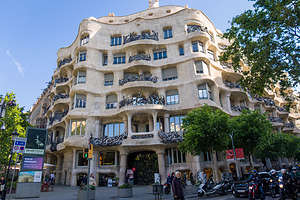 Gaudi's Casa Mila (La Predera)The exterior of the building is sprinkled with bits of blue, mauve, and green mosaic tiles and studded with wave-shaped window frames and protruding balconies. There wasn’t a straight line to be found. The rooftop resembles the back of a dragon and has four colorful chimneys.
Gaudi's Casa Mila (La Predera)The exterior of the building is sprinkled with bits of blue, mauve, and green mosaic tiles and studded with wave-shaped window frames and protruding balconies. There wasn’t a straight line to be found. The rooftop resembles the back of a dragon and has four colorful chimneys.
We didn’t get to see the interior of Casa Battlo, because it is currently undergoing renovations. They still do allow visitors, but since we couldn’t see everything, we chose instead to buy tickets to enter La Pedrera (Casa Mila), one of Gaudi’s trademark works and a Modernisme icon. It is located at Passeig de Gràcia, 92. It is very popular, so it’s a good idea to buy a timed-entry ticket in advance: http://www.lapedrera.com/es/prepara-la-visita/tarifas
The building was commissioned in 1906 by the wealthy industrialist Pere Mila i Camps. That is why it is sometimes called Casa Mila. However, its official name is La Pedrera, which means “stone quarry,” because of its rocky, jagged facade. La Pedrera was actually a pejorative name given to it by the wealthy neighbors who thought it looked like a dirty and ugly stone quarry. Well, they got that one wrong.
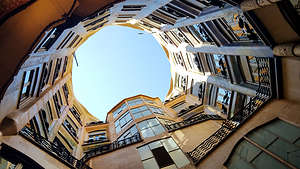 Atrium of Gaudi's Casa MilaSince we had tickets, we got online for our 9:30 timed entry. The building is considered to be the purest of Gaudi’s interiors and to have been designed at the height of his abilities. It was also the last civil engineering project he would undertake in his career. Most of the rest of his life would be spent on his religious devotion and the building of the amazing Sagrada Familia, which we will get to later.
Atrium of Gaudi's Casa MilaSince we had tickets, we got online for our 9:30 timed entry. The building is considered to be the purest of Gaudi’s interiors and to have been designed at the height of his abilities. It was also the last civil engineering project he would undertake in his career. Most of the rest of his life would be spent on his religious devotion and the building of the amazing Sagrada Familia, which we will get to later.
Our first stop in the building was a large open-to-the-sky courtyard, 16 floors high. This was very innovative for its time. Not only was it aesthetically beautiful, but it served the function of improving the lighting and ventilation on all 16 apartments (there was one apartment per floor).
We got to see a replica of one of those apartments. Wow! What it must have been like to live in this elegant and unique building. There was so much natural light flooding in from the courtyard into each of the rooms that circled it. Gaudí actually designed some of the decorative elements, such as the mouldings, door knobs, and flooring.
 Rooftop of Gaudi's Casa MilaHowever, by far my favorite part of the tour was the bizarre rooftop, covered with weirdly shaped chimneys, reminiscent of Star Wars figures, and rightly so, as it was these chimneys that inspired George Lucus’ stormtroopers’ masks. There are 36 chimneys in total, some of them decorated with mosaic, stones, marble, and glass. The 6 largest ones have staircases inside and 2 of them are ventilation shafts - always coming form and function.
Rooftop of Gaudi's Casa MilaHowever, by far my favorite part of the tour was the bizarre rooftop, covered with weirdly shaped chimneys, reminiscent of Star Wars figures, and rightly so, as it was these chimneys that inspired George Lucus’ stormtroopers’ masks. There are 36 chimneys in total, some of them decorated with mosaic, stones, marble, and glass. The 6 largest ones have staircases inside and 2 of them are ventilation shafts - always coming form and function.
Since Gaudi did not like straight lines, even the floor of the roof was uneven so we had to watch our step. We spent a good deal of time up there enjoying both the chimneys as well as the panoramic view over Barcelona. We could even see the Sagrada Familia!
Next stop on the Gaudi Tour - Park Guell, a public park designed by Gaudi, located atop Carmel hill, just a little over a mile and a half way.
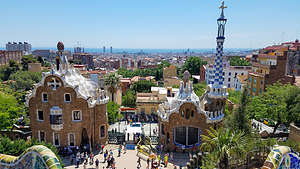 Park Guell's monument zoneMost of the park is free, except for the very popular Monumental Zone, where most of Gauid’s iconic creations are. Only 400 visitors are allowed in each hour, so it’s a good idea to buy a timed-entry ticket in advance: https://parkguell.barcelona/en/planning-your-visit/prices-and-times
Park Guell's monument zoneMost of the park is free, except for the very popular Monumental Zone, where most of Gauid’s iconic creations are. Only 400 visitors are allowed in each hour, so it’s a good idea to buy a timed-entry ticket in advance: https://parkguell.barcelona/en/planning-your-visit/prices-and-times
We had some time to kill before our 1:00 entry, so we wandered around the free part of the park for awhile, before lining up like cattle with the other 398 lucky ticket holders to enter the Monumental Zone.
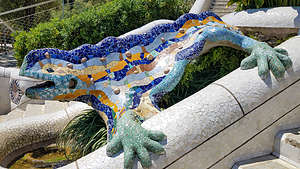 Park Guell's monument zoneThe Zone made me feel a bit like I had entered the board game Candyland or some other bizarre fanciful land. There are two Hansel and Gretel gatehouses, a multicolored mosaic lizard named “El Drac” guarding a whimsical staircase, long serpentine wavy benches, and a panoramic view terrace supported by a forest of columns. It was pretty whimsical.
Park Guell's monument zoneThe Zone made me feel a bit like I had entered the board game Candyland or some other bizarre fanciful land. There are two Hansel and Gretel gatehouses, a multicolored mosaic lizard named “El Drac” guarding a whimsical staircase, long serpentine wavy benches, and a panoramic view terrace supported by a forest of columns. It was pretty whimsical.
The original intention of Guell was to build 60 single-family homes here, but that didn’t work out, and the project was stopped. In 1923 the park became city property, and in 1926 it opened as a public park. it was listed as a UNESCO World Heritage Site in 1984.
One of the model houses was bought by Gaudi, and he lived in it from 1906 to 1925. You can visit the interior of this home, but the line was much too long, so we decided to move on to our final stop on our Gaudi tour - the Sagrada Familia, for which we had 3:45 entry tickets.
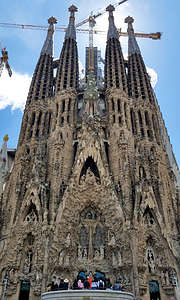 Gaudi's Sagrada FamiliaThe Sagrada Familia is Antoni Gaudi’s magnum opus, a creation so incredibly beautiful and innovative that it must be experienced in person to truly appreciate. Words cannot do it justice. You simply must see it for yourself.
Gaudi's Sagrada FamiliaThe Sagrada Familia is Antoni Gaudi’s magnum opus, a creation so incredibly beautiful and innovative that it must be experienced in person to truly appreciate. Words cannot do it justice. You simply must see it for yourself.
But first some logistics:
The church is open to the public, but since it is the second most visited site in Spain (the Alhambra in Grenada is the first), you really have to buy timed-entry tickets well in advance: http://www.sagradafamilia.org/en/. I highly recommend getting the audio guide or taking a guided tour as there is so much so see and learn in this massive church.
If you are interested in visiting the towers, note that these require a special ticket as tower access is not included in the main tickets. You can book a tower entrance ticket along with your main ticket on the same website.
 View outside the windows of the Nativity TowerWhen purchasing our tickets, several months before leaving, we agonized for some time over what time of day was best to go, and which, if any, tower to go up. We chose the Nativity Tower because that was the only one completed during Gaudi’s lifetime, so it was purely his work. As far as the timing, the consensus seemed to be that the light streaming through the beautiful stained glass windows was most heavenly between 5 and 6 pm. Although, there were plenty of people suggesting other times of day would be preferable for photographing the exterior. Personally, I think any time of day would be incredible. Anyway, we purchased tickets for a 3:45 entry (with audio guide), where we could have access to the Nativity Tower at 4:00. That way we could just hang out in the basilica afterwards and photograph the interior for as long as we wanted.
View outside the windows of the Nativity TowerWhen purchasing our tickets, several months before leaving, we agonized for some time over what time of day was best to go, and which, if any, tower to go up. We chose the Nativity Tower because that was the only one completed during Gaudi’s lifetime, so it was purely his work. As far as the timing, the consensus seemed to be that the light streaming through the beautiful stained glass windows was most heavenly between 5 and 6 pm. Although, there were plenty of people suggesting other times of day would be preferable for photographing the exterior. Personally, I think any time of day would be incredible. Anyway, we purchased tickets for a 3:45 entry (with audio guide), where we could have access to the Nativity Tower at 4:00. That way we could just hang out in the basilica afterwards and photograph the interior for as long as we wanted.
A little background:
Gaudi did not do the initial plans for this church, nor was he its first architect. However, when the first architect, Francisco Paula de Vilar, resigned in 1882, Gaudi took over the project and made radical changes to the original plans. To say that his design was unconventional is a gross understatement, but we had seen enough of Gaudi’s works today to expect nothing less.
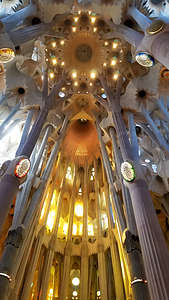 Interior of the Sagrada FamiliaGaudi was only 31 when he took over the project, and he continued in that role for 43 years until his tragic death in 1926, when he was hit and killed by a trolley car on his way to confession. From 1914 until his death he abandoned all other projects and completely devoted himself to this church, even moving into the workshop on site.
Interior of the Sagrada FamiliaGaudi was only 31 when he took over the project, and he continued in that role for 43 years until his tragic death in 1926, when he was hit and killed by a trolley car on his way to confession. From 1914 until his death he abandoned all other projects and completely devoted himself to this church, even moving into the workshop on site.
At the time of his death, less than 25% of the church was complete. However, he knew he would never live to see the basilica completed, so he left his vision of the building for future architects in the form of models and sketches. Construction of the church is still in progress -- hence all the cranes and scaffolding - and is expected to be finished in 2026 (a century after his death).
The building, which is a combination of Gothic, Catalan Modernism, and Art Nouveau styles, combines all of the elements that Gaudí used and experimented with in his earlier works - the predominance of wavy curves over straight lines, parabolas instead of circles, the use of vegetal and other organic motifs, intricate decoration and detail, and brightly colored glass and mosaics.
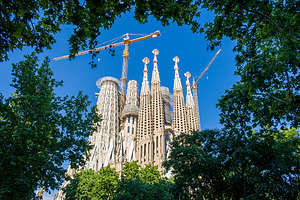 One last view of the Sagrada FamiliaThe exterior:
One last view of the Sagrada FamiliaThe exterior:
Currently there are eight 330-foot spires topped with crosses. When the church is completed there will be 18: 12 representing the apostles, (over the three entrances), 4 taller ones representing the evangelists, an even higher one designated for the Virgin Mary, and the final 18th one, which will be the highest one in the middle, representing Jesus Christ.
There are three facades, each depicting a phase in the life of Jesus: nativity, passion, and glory. Only the Nativity Facade was completed during Gaudi’s lifetime. The Passion Facade was completed in 2006, and the Glory Facade is still under construction.
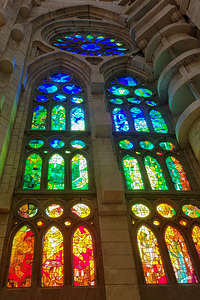 Sagrada Familia stained glass windowsThe interior:
Sagrada Familia stained glass windowsThe interior:
Like most basilicas, the Sagrada Família has a cruciform (Latin cross) plan, with a five-aisled nave, a transept with three aisles, and an apse with seven chapels. It is 300 feet long and 200 feet wide - large enough to accommodate 8,000 worshippers.
The main nave rises far above the other naves and is connected to the transept, beyond which is the apse and the altar, lit by light filtering through the stained glass windows. Gaudi is buried in the crypt below the apse.
Suspended from a canopy above the altar, is an Expressionist depiction of the crucifixtion, in which Jesus hangs on a cross, looking upwards - an unconventional pose as Jesus is usually depicted looking downwards or sideways. This was done deliberately to represent Jesus looking upwards to ask for support from God.
Using nature as his inspiration, the roof is held up by 56 tree-like columns, complete with branches and leaves, creating the effect of a forest canopy. The columns are made of materials of different hardness. The longest and thickest columns are made of red porphyry, a very hard volcanic rock; the dark, somewhat smaller pillars are made of basalt; and the outermost row of columns are made from a relatively soft granite from Montjuic in Barcelona.
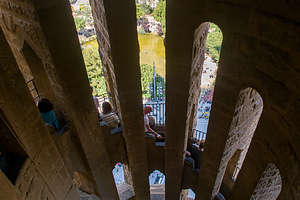 Climbing up the Nativity TowerIn contrast to the Gothic style, Gaudí’s design requires no supporting side walls, so he had the freedom to incorporate large stained glass windows to let in natural light. The stained glass windows are absolutely breathtaking. The sunlight filtering through them creates a magical and effect. Morning light shines most heavenly through the blues, greens, and other cool colors of the windows on one side of the church, while evening light performs its magic flowing through the reds, oranges, and other warm tones on the other.
Climbing up the Nativity TowerIn contrast to the Gothic style, Gaudí’s design requires no supporting side walls, so he had the freedom to incorporate large stained glass windows to let in natural light. The stained glass windows are absolutely breathtaking. The sunlight filtering through them creates a magical and effect. Morning light shines most heavenly through the blues, greens, and other cool colors of the windows on one side of the church, while evening light performs its magic flowing through the reds, oranges, and other warm tones on the other.
Bell Towers:
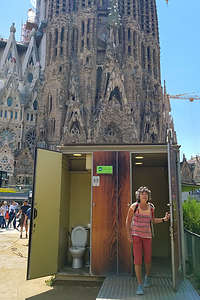 Lolo finishing her tour of the Sagrada FamiliaAs I mentioned, you can purchase tickets to climb up the towers in either the Nativity or Passion facades. We chose the Nativity Facade, because that was the only facade completed before Gaudi’s death. It involved climbing up 504 steps (no railings), which coiled round and round the tightly closed walls, like a snail. Looking down could be a bit scary for those uncomfortable with heights.
Lolo finishing her tour of the Sagrada FamiliaAs I mentioned, you can purchase tickets to climb up the towers in either the Nativity or Passion facades. We chose the Nativity Facade, because that was the only facade completed before Gaudi’s death. It involved climbing up 504 steps (no railings), which coiled round and round the tightly closed walls, like a snail. Looking down could be a bit scary for those uncomfortable with heights.
Along the way, we had views out the small windows of the sculptures on the rest of the Nativity facade. From the top there was an excellent view of eastern Barcelona and the mountains.
Wrap-Up
After 15 miles of walking and three tours of Gaudi’s works, I think we had accomplished what we had set out to do - immersing ourselves in the full Gaudi experience. It was an exhausting but very satisfying day. Time for a glass of wine and a toast to Antoni Gaudi, a truly unconventional and inspirational artist.
Speaking of unconventional, Herb's favorite photo of the Sagrada Familia is me exiting a porta potty, with a toilet in the foreground. Immature or genius? Who is to say?
Description
While I will not attempt to do an in-depth description of all Barcelona has to offer -- there are numerous guidebooks to do just that -- the following are some interesting sites that we enjoyed:
Las Ramblas pedestrian mall - one hour stroll from Playa de Catalunya to the La Rambla del Mar on the waterfront
- Broad pedestrian boulevard with souvenir hawkers, street artists, mimes, living statues, cafes, and shops
- More charming in the morning - grab breakfast at a market cafe
- Along the way:
- Fountain of Canaletes - ornate black and gold lamp post with a fountain at its base. Legend says that a drink from it ensures you will return to Barcelona one day
- Wavy tile work - represents the stream that once flowed here
- Look up to see the city’s characteristic shallow balconies with floor to ceiling windows
- Chairs fixed to the sidewalk at jaunty angles
- Betlem Church - 17th century Baroque church with sloping roofline, ball-topped pinnacles, corkscrew columns
- Rambla of Flowers - flower stands
- La Boqueria Market
- Plaça de la Boqueria - here you will see the Joan Miro mosaic in red, white, yellow, and blue
- Plaça Reial - dotted with palm trees and surrounded by yellow buildings with white trim this placa has old-fashioned taverns as well as modern bars with patio seating
- Palau Guell - apartment building designed by Antoni Gaudi. This was the first of his Modernista buildings, and you can see his emerging nonlinear style in the arches and doorways
- Christopher Columbus monument
- Rambla del Mar - wavy wooden walkway along the waterfront
Barri Gotic (Historic Gothic Quarter) walk - 1.5 hour self-guided tour from Placa de Catalunya to Placa del Rei
- Stroll the narrow Medieval lanes of Barcelona’s enchanting old quarter
- Relics of ancient Rome, 14th century Gothic churches, cobblestone lanes lined with shops, bars, and restaurants
- Along the way:
- Avinguda del Portal de l’Angel - once a major city gate. The angel statue atop the gate was said to keep Barcelonans safe from plagues and bid voyagers a safe journey
- Church of Santa Ana - 12th century Catalan Gothic church
- Els Quatre Gats - circa 1900 bohemian artist hangout, where Picasso had his first one-man show
- Playa Nova - flanked by two Roman towers that once guarded the entrance ate of the ancient Roman city of Barcino
- Barcelona Cathedral - 14th century Flamboyant-style (donation entrance 7 euros)
- Sardana dances, patriotic dance in which Barcelonans link hands and dance in a circle - on Sunday at 11:15 and many Saturdays at 18:00
- Casa del Ardiaca - old mansion that now functions as the city archives
- Carved mail slot (right of door) carved by a 19th century Modernista architect
- From the courtyard, climb to the balcony for views of the cathedral steeple and gargoyles
- Jewish quarter (El Call) - walk along the narrow passages and alleys where 4,000 Jews were forced to live
- Ruins of Roman Temple of Augustus - site where Romans founded the town of Barcino in 12 BC
- Placa del Rei - reminders of Barcelona’s medieval Golden Age
Barceloneta
- Traditional fishing neighborhood with gritty charm and good seafood restaurants
- Gorgeous man-made beach several miles long
- Stroll 4.5 km promenade - from La Estrella Herida to Peix
- La Estrella Herida - Contemporary 33-ft. beach sculpture of 4 stacked leaning steel cubes with windows, by Rebecca Horn.
- Peix (Fish) - giant copper-like Peix (Fish) sculpture by Frank Gehry glitters in the sunlight
La Sagrada Familia - Antoni Gaudi’s grand masterpiece
- Located in Eixample residential neighborhood, 1.5 miles north of Placa de Catalunya
- Hours: Mon - Sat 9:00 am - 8:00 pm; Sun 10:30 am - 8:00 pm)
- Timed-entry tickets - buy in advance: http://www.sagradafamilia.org/en/
- Gaudi labored on the Sagrada Familia for 43 years, from 1883 until his death in 1926. Work continued after his death and the church is expected to be finished in 2026 (a century after his death)
- Exterior
- Currently there are eight 330-foot spires topped with crosses. When completed there will be 18 - 12 representing the apostles, (over the three entrances), 4 taller ones representing the evangelists, an even higher one designated for the Virgin Mary, and the final 18th one, which will be the highest one in the middle, representing Jesus Christ
- The three facades - Nativity, Passion, and Glory, will chronicle Christ’s life from Birth, to crucifixion, to resurrection. Only the Nativity Facade was completed during Gaudi’s lifetime. The Passion Facade was completed in 2006, and the Glory Facade is still under construction
- Interior
- Floor plan is that of a Latin cross, 300 feet long and 200 feet wide - large enough to ultimately accommodate 8,000 worshippers
- The roof is held up by 56 tree-like columns, complete with branches and leaves, creating the effect of a forest canopy
- Sunlight filtering through stained glass windows creates a hypnotic, magical effect of a dappled rainforest canopy. Morning light shines in through blues, greens, and other cool colors, while evening light flows in reds, oranges and other warm tones.
Park Guell - Gaudi’s most ambitious project after Sagrada Familia
- 30 minute walk from Sagrada Familia
- Fanciful and playful space - two Hansel and Gretel gatehouses, dragon guarding a whimsical staircase, wavy benches, and a panoramic view terrace supported by a forest of columns
- Located 2 miles (uphill) to the northwest of Sagrada Familia
- Much of the park is free, except for the Monumental Zone where all the iconic Gaudi features are
- Zona Monumental (open daily 8:00 am to 8:30 pm)
- 400 visitors allowed in each hour
- Timed entry tickets - buy in advance (€ 10)
https://parkguell.barcelona/en/planning-your-visit/prices-and-times
L’Eixample - heart of Barcelona’s Modernista architectural movement
- Located north of the Old City
- Modernista - Free-flowing organic style that lasted from 1888 to 1906. It is characterized by wave-like curves, asymmetry, brightly colored glass and tile, and vegetal and other organic motifs
- Block of Discord - two of Gaudi’s colorful Modernista facades on Passeig de Gracia near the Metro stop)
- Casa Batllo - designed by Gaudi at his hallucinatory best
- Wave-shaped window frames and balconies, mushroom-shaped fireplace, and roof topped with a fanciful dragon-inspired roof
- Open daily from 9:00 am to 9:00 pm (but currently under renovation)
- Timed entry tickets - buy in advance
(€25)https://www.casabatllo.es/venta-entradas/ - La Pedrera (Casa Mila) - one of Gaudi’s trademark works and an icon of Modernisme
- Half hour walk from Park Guell
- Purist Gaudi interior in Barcelona
- One of the most notable elements of the building is the roof, crowned with skylights, staircase exits, fans, and chimneys.
- Open daily from 9:00 am - 8:30 pm
- Timed-entry ticket - buy in advance http://www.lapedrera.com/es/prepara-la-visita/tarifas
Montjuic - Large hill overlooking the city with Romanesque art, a fort, beautiful gardens, and art galleries and museums
- Fundacio Joan Miro (closed Mondays) - Barcelona’s best-looking gallery, set among gardens overlooking the city
- Tues - Sat 10:00 - 8:00, Sun 10:00 - 3:00
- Tickets: €13 https://www.fmirobcn.org/en/visit-us/opening-hours-and-prices/
- Montjuic Castle - at the top with great views of the city
- Dating from the late 17th century, for most of its dark history it has been used as a political prison and killing ground
- Tickets - €5
Picasso Museum - (closed Mondays)
- Set in five contiguous medieval stone mansions
- The collection, which includes more than 3500 of his works, concentrates on his formative years (from age 14 to 23) in Barcelona (pre-1904)
- Tues - Sun 9:00 am - 7:00 pm
- 12 € for timed-entry ticket (buy ahead of time on the museum website)
Parc de la Ciutadella (Citadel Park) - located in La Ribera section of the city (across the street from Motel One)
- Site of the 1888 Barcelona Universal Exposition, Spain's first International World's Fair
- Barcelona’s largest park - its 70-acre grounds include a small lake with rental rowboats, an ornamental fountain (which Antoni Gaudi helped design), the city zoo, a greenhouse, a winter garden, and plenty of green areas to sit and relax
Home
Wednesday, April 17, 2019 - 9:15am by Lolo550 miles and 8.5 hours from our last stop - 1 night stay
Travelogue
One problem with getting back to the Bay Area from the Eastern Sierra in winter and even into spring is that most of the passes can become impassable in inclement weather. The only alternative in that case is making the long journey south to Bakersfield and then up I5. It adds 2 hours to the journey, but is always dependable. A forecast of possible snow in the morning was enough to send us south. The first part of the drive south from Bishop to Route 58 is highly scenic. I5 gets a bit monotonous, but it gets the job done.
The trip was great, but it certainly felt great to be sleeping in our own bed again.
Description
Our home in Sonoma Valley
Bishop
Monday, April 8, 2019 - 5:00pm by Lolo130 miles and 5 hours from our last stop - 1 night stay
Travelogue
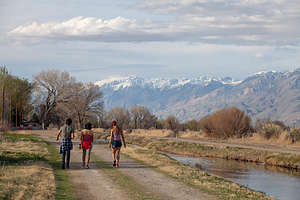 Strolling with Andrew and Celeste in BishopAfter leaving the Racetrack Playa, we drove back to the Death Valley / Big Pine Road and hung a left. Although dirt, it's a very passable (even with 2WD) road that traverses the northern part of Death Valley starting near Ubehebe Crater. It brings you out of the west side of the park into the town of Big Pine along Highway 395, one of the most scenic roads in California.
Strolling with Andrew and Celeste in BishopAfter leaving the Racetrack Playa, we drove back to the Death Valley / Big Pine Road and hung a left. Although dirt, it's a very passable (even with 2WD) road that traverses the northern part of Death Valley starting near Ubehebe Crater. It brings you out of the west side of the park into the town of Big Pine along Highway 395, one of the most scenic roads in California.
Leaving the park this way made even more sense now that our oldest son and his wife are living in Bishop, just 15 miles north of Big Pine. A quick text to invite ourselves to their place was well accepted enthusiastically, so we spent a fun night with them before heading on home.
Description
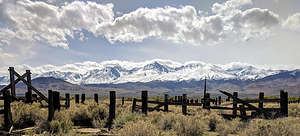 Along 395 to BishopBishop is my favorite town in the Eastern Sierra. It is located along US 395 between the towns of Mammoth Lakes and Big Pine. It lies at the northern end of the Owens Valley with the Sierra Nevada mountains to the east and the White Mountains to the west.
Along 395 to BishopBishop is my favorite town in the Eastern Sierra. It is located along US 395 between the towns of Mammoth Lakes and Big Pine. It lies at the northern end of the Owens Valley with the Sierra Nevada mountains to the east and the White Mountains to the west.
One of the town’s claims to fame is that it is the "Mule Capital of the World," holding a week-long festival each May called Bishop Mule Days. Part mule show, part test of skills, and part Wild West Show, this annual event has been attracting crowds for over its 47 year history, growing from a crowd of 200 in its early days to becoming an international world class event with more than 30,000 fans. Over the course of a week, more than 700 mules compete in 181 events including calf roping, steer roping, barrel racing, flat racing, carriage driving, team chariot racing, and even dressage.
The reason we go to Bishop is for the excellent rock climbing. The three major climbing areas in Bishop include:
The Owens River Gorge is a steep 10 mile long canyon just north of Bishop that is a very popular destination for rock climbing. With 416 sport-climbing and 52 trad routes it is California’s most concentrated sport climbing area. The climbing is on volcanic tuff and features edges, pockets and cracks. Although there is a full range of difficulty level, the best climbs are in the 5.10 to 5.11 range. The most popular walls are located in the Central Gorge – Warm Up Wall, the Pub, the Social Platform, and the Great Wall of China, which feature tons of 5.8 to 5.11 sport routes. Summers get a bit too hot to climb in the gorge.
Buttermilk Country, one of California’s premier bouldering destinations, is located southwest of Bishop along the western edge of the Owens Valley. These massive glacial erratic boulders sit in the foothills of the Sierra Nevada under an impressive backdrop of high peaks just a mere four miles to the west. There are 243 bouldering routes, many of which top out at over 20 feet.
The Volcanic Tablelands, another popular bouldering destination, lie just north of Bishop in an area where the floor of the Owens Valley rises abruptly, forming a 300 foot-high volcanic plateau. Along the southern tip of the plateau there are numerous canyons and washes containing thousands of boulders. The Happy Boulder area with 418 routes and the Sad Boulder area with 187 routes are the most popular. Because of its 4,500 foot elevation, the Volcanic Tablelands are climbable year round.
Death Valley National Park
Saturday, April 6, 2019 - 4:15pm by Lolo245 miles and 6.5 hours from our last stop - 2 night stay
Travelogue
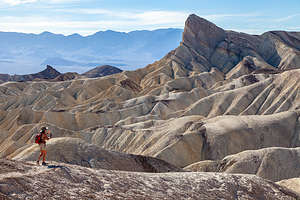 Golden Canyon TrailWe had been to Death Valley numerous times before, but Herb never seems to get enough of it. He loves everything about it - the heat, the remoteness, the ability to be totally alone (+ me) in a vast pristine expanse, and, of course, the stark beauty of its barrenness.
Golden Canyon TrailWe had been to Death Valley numerous times before, but Herb never seems to get enough of it. He loves everything about it - the heat, the remoteness, the ability to be totally alone (+ me) in a vast pristine expanse, and, of course, the stark beauty of its barrenness.
Despite having been here multiple times, there were still some things on our list of things to do - primarily the hike from Golden Canyon to Zabriskie Point, considered the best hike in the Park. We had done the 2-mile Golden Canyon Interpretive Trail in 2014, but had run out of daylight to complete the whole 7-mile Golden Canyon, Zabriskie Point, Gower Gulch loop. Today was the day.
Since the Golden Canyon section of the hike is the most spectacular section of the hike, we decided to do it in reverse, so we would hit it in the golden hour right before sunset. This meant starting off along the trail that ran parallel to Badwater Road for awhile before climbing up through a canyon along gravel-filled wash, which is Gowers Gulch.
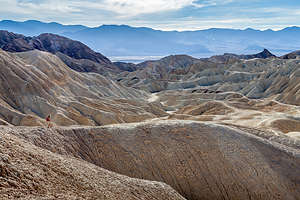 Lolo on the Golden Canyon trailRather than take a left at the Badlands Loop Trailhead (at 2.3 miles), which would have brought us back over and down into the Golden Canyon for a 4.5-mile loop hike, we continued straight up for another mile and a half to Zabriskie Point, probably the best overlook in the park, where there is a panoramic view of Golden Canyon and the surrounding vibrantly colored badlands.
Lolo on the Golden Canyon trailRather than take a left at the Badlands Loop Trailhead (at 2.3 miles), which would have brought us back over and down into the Golden Canyon for a 4.5-mile loop hike, we continued straight up for another mile and a half to Zabriskie Point, probably the best overlook in the park, where there is a panoramic view of Golden Canyon and the surrounding vibrantly colored badlands.
Most people get to Zabriskie Point via car and then just walk the short distance out to the overlook. We, however, felt that we had truly earned the view, as we gazed down at the canyons and badlands below us that we had traversed to get here.
Unfortunately, you can’t be in every place during the golden hour, and since we didn’t want to be hiking down in the dark, we started our trek down, this time taking the Badlands Loop over towards the Golden Canyon Trail. There were parts of the way down that were a bit sketchy, with loose scree and steep drop-offs, but nothing too precarious.
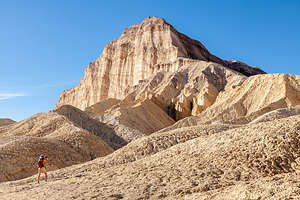 Golden Canyon TrailThe most dramatic part of the trail with the biggest expanses and interesting rock formations was the section along the Badlands Loop over to the top of the Golden Canyon Trail. It was just hard to keep my eyes on the trail because the scenery was so beautiful.
Golden Canyon TrailThe most dramatic part of the trail with the biggest expanses and interesting rock formations was the section along the Badlands Loop over to the top of the Golden Canyon Trail. It was just hard to keep my eyes on the trail because the scenery was so beautiful.
We got back to the car with sufficient daylight to find camping for the night. Death Valley, like Carrizo Plains, allows dispersed camping as long as you are a mile away from a main road. The nearest place for us to go was one of the dirt canyon roads off of the West Side Road. Since it was getting late, we chose the first one, Trail Canyon, and drove a bumpy, rocky mile up it towards the canyon. It was a nice sport, and the price was right.
The next morning after our normal morning routine, we headed out to explore more of the park. It’s amazing how my perception of normal was evolving after only my third night sleeping in the back of the same vehicle I take to the grocery store.
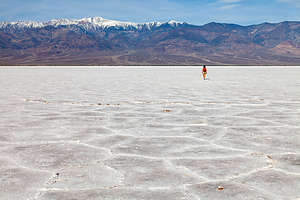 Salt hexagons of Badwater BasinOur first stop of the day was Badwater Basin, which at 282 feet below sea level, is the lowest, driest, hottest place in North America. A boardwalk leads out across the basin, at the end of which you can continue out onto the salt flats themselves, a surreal, otherworldly highway made of table salt which organizes itself into interconnecting hexagonal honeycombs. These shapes are the result of repeated freezing and thawing and evaporation cycles that gradually push the thin salt crust up into a hexagon, nature’s most efficient shape - even bees know that when they build their honeycombs. You can go on for miles on the salt flats if you choose, all the way to the other side of the Valley, but we chose to go for just a little over a mile before turning back.
Salt hexagons of Badwater BasinOur first stop of the day was Badwater Basin, which at 282 feet below sea level, is the lowest, driest, hottest place in North America. A boardwalk leads out across the basin, at the end of which you can continue out onto the salt flats themselves, a surreal, otherworldly highway made of table salt which organizes itself into interconnecting hexagonal honeycombs. These shapes are the result of repeated freezing and thawing and evaporation cycles that gradually push the thin salt crust up into a hexagon, nature’s most efficient shape - even bees know that when they build their honeycombs. You can go on for miles on the salt flats if you choose, all the way to the other side of the Valley, but we chose to go for just a little over a mile before turning back.
On the way back north from Badwater Basin, we took a 1.5-mile bumpy dirt road to the trailhead for the hike to Natural Bridge. From the parking lot, we immediately entered the mouth of a canyon and hiked uphill for about a ½ mile before arriving at our goal, a 50-foot high massive rock that spans the canyon.
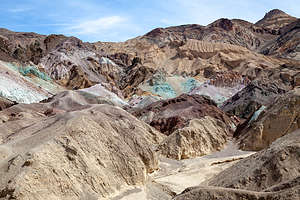 Artists DriveContinuing north, we turned off onto the one-way, highly scenic Artists Drive, a 9-mile paved spur road that winds through a colorful display of sedimentary and volcanic rock. We stopped at a viewpoint called Artists Pallet, named for the amazing rainbow of colors – red, pink, yellow, orange and brown – that paint the hills. Unfortunately, it was high noon, not the best time for photography. This would be a great place to come back to at sunset, but that was not in our program for the day.
Artists DriveContinuing north, we turned off onto the one-way, highly scenic Artists Drive, a 9-mile paved spur road that winds through a colorful display of sedimentary and volcanic rock. We stopped at a viewpoint called Artists Pallet, named for the amazing rainbow of colors – red, pink, yellow, orange and brown – that paint the hills. Unfortunately, it was high noon, not the best time for photography. This would be a great place to come back to at sunset, but that was not in our program for the day.
We skipped the Harmony Borax Works, as we had been there on a recent trip, but I highly recommend it for anyone interested in the human history of Death Valley, which pretty much the revolves around the mining of borax.
A little further north from the Borax Works is the Salt Creek Interpretive Trail, a rare chance to see water in Death Valley. It’s not exactly a hike, but more of a pleasant stroll on a mile-long boardwalk. The tiny little creek here is home to the inch-long Salt Creek Pupfish, a hearty little creature that somehow manages to survive these harsh conditions. In past visits, we had not seen any, but this time we were fortunate enough to be here in springtime when they are out and about and looking for a partner (or partners) to breed with.
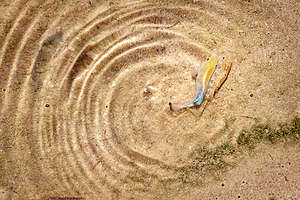 Mating pupfish at Salt CreekWe actually got to see the courtship ritual, which was quite fascinating. We could tell which ones where the males because they were luminescent blue, to attract the ladies and let them know they were interested and ready to breed. The males were quite territorial and aggressive, chasing other males away from their turf, while simultaneously trying to entice a female into his turf. Once he has lured one in, they cuddle up beside each other, form and s-shape, and start to wiggle. During this wiggle, the female releases an egg and the male releases sperm, which immediately fertilizes the egg. Sometimes, the female hangs around for another round. The fertilized eggs take about 10 days to hatch. A single female typically lays somewhere between 50 and 800 eggs in a single season.
Mating pupfish at Salt CreekWe actually got to see the courtship ritual, which was quite fascinating. We could tell which ones where the males because they were luminescent blue, to attract the ladies and let them know they were interested and ready to breed. The males were quite territorial and aggressive, chasing other males away from their turf, while simultaneously trying to entice a female into his turf. Once he has lured one in, they cuddle up beside each other, form and s-shape, and start to wiggle. During this wiggle, the female releases an egg and the male releases sperm, which immediately fertilizes the egg. Sometimes, the female hangs around for another round. The fertilized eggs take about 10 days to hatch. A single female typically lays somewhere between 50 and 800 eggs in a single season.
We continued north on Scotty’s Castle Road towards Ubehebe Crater. This is a beautiful stretch of road, with desert views to the west and alluvial fans and mountains to the east. Unfortunately, Scotty’s Castle is still closed from the flood damage it experienced back in 2015, and is not expected to reopen until 2020. Too bad, as that is truly an interesting part of Death Valley’s human history.
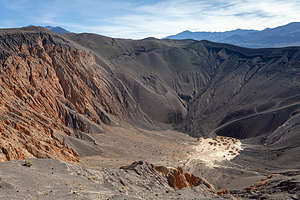 Ubehebe Crater RimHowever, the road was open to Ubehebe Crater, another one of Death Valley’s impressive geological features. The crater is huge - a half-mile wide, 750-feet deep, formed by volcanic explosions several thousand years ago. Last time we were here, we hiked down to the bottom of the crater. The hike back up was pretty exhausting because of the steepness and loose cinders.
Ubehebe Crater RimHowever, the road was open to Ubehebe Crater, another one of Death Valley’s impressive geological features. The crater is huge - a half-mile wide, 750-feet deep, formed by volcanic explosions several thousand years ago. Last time we were here, we hiked down to the bottom of the crater. The hike back up was pretty exhausting because of the steepness and loose cinders.
Ubehebe is not the only crater in this part of Death Valley. There is a cluster of craters to the south and west of Ubehebe, the largest being Little Hebe Crater.
This time we decided to hike around the rim of the crater, with a short side trip to Little Hebe Crater along the way. The whole hike around the rim, including Little Hebe is 2 ¼ miles. Although most of the rim is level, there are some steep sections, as the west side of the crater is 270 feet higher than the east side. That plus the loose cinders and the drop-offs made it more than just a casual stroll.
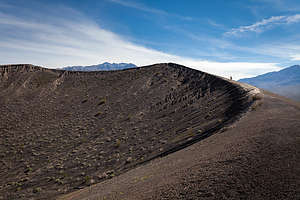 Ubehebe Crater RimFortunately for those that don’t hike, the best view of Ubehebe Crater is actually from the parking lot, where the you see the bright yellow and orange stone of the opposite side is exposed.
Ubehebe Crater RimFortunately for those that don’t hike, the best view of Ubehebe Crater is actually from the parking lot, where the you see the bright yellow and orange stone of the opposite side is exposed.
The 27-mile dirt road to Death Valley’s famous Racetrack, where rocks mysteriously move across the dry lakebed on their own accord, starts right near the parking lot for Ubehebe Crater, so we figured we would go there to spend the night.
Road conditions seemed a little rougher than the last time we drove it, probably because of the winter storms that had closed so many of the other roads in the park. Still, we were able to move along at a good 20 mph pace.
After 19 miles of incredible natural desert scenery, we came upon a bit of a man-made attraction at Teakettle Junction, where the sign marking the junction of Racetrack and Hunter Mountain is strung with dozens of old teakettles.
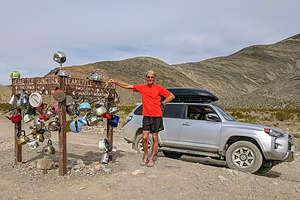 Teakettle Junction on way to the RacetrackNo one quite knows how this tradition began, but rumor has it that kettles were hung to show early settlers that there was water nearby. Another theory is that it was considered good luck to leave a kettle with a message on or in it for fellow travelers to read. When the number of teakettles get to be too much, Rangers remove them, and the process begins all over again.
Teakettle Junction on way to the RacetrackNo one quite knows how this tradition began, but rumor has it that kettles were hung to show early settlers that there was water nearby. Another theory is that it was considered good luck to leave a kettle with a message on or in it for fellow travelers to read. When the number of teakettles get to be too much, Rangers remove them, and the process begins all over again.
For this afternoon, we continued straight for another 6 miles to the Grandstand Parking Area at the northern end of the Racetrack Playa (dry lakebed), which is 3 miles long and 2 miles wide. Rising from the playa is a large, dark outcrop of quartz monzonite, which is actually the tip of a mountain buried long ago by material eroded from the surrounding mountains. It looked like an island in a sea of clay.
Unfortunately, we hadn’t “raced” fast enough to get here. As we walked across the playa towards the Grandstand, the sun dipped behind the mountains, putting it in shadow. So close.
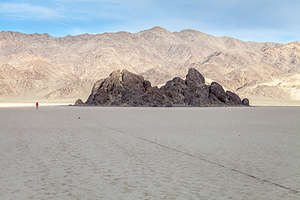 Rock racing Lolo to the GrandstandNo camping is allowed in the parking areas alongside the playa, so we continued on to the primitive campground, just two miles beyond, where there are a half a dozen or so places to camp, only two of which were occupied.
Rock racing Lolo to the GrandstandNo camping is allowed in the parking areas alongside the playa, so we continued on to the primitive campground, just two miles beyond, where there are a half a dozen or so places to camp, only two of which were occupied.
The next morning we drove back out from whence we came and stopped once more to walk out on the playa, this time at the southern end, where most of the “moving” rocks hang out. It was easy to find those that had moved by the tracks they left behind in the clay.
Scientists have been studying this strange rock behavior for decades and think they have finally solved the mystery. The theory is that after a rain, the surface of the playa, which is clay, becomes quite slippery. Accompanying that loss of friction with the strong winds that blow out of the Saline Valley, sometimes as high as 70 mph, and you get a sufficient force to actually move a rock across the slick surface, some of which are as large as 1,000 pounds. Some of them have moved as much as several hundred feet, leaving long tracks behind them showing the direction of their journey.
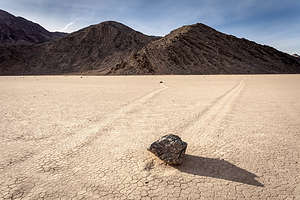 Mysterious moving rocks of the RacetrackUsing GPS measurements, scientists have mapped, measured, and even named 162 rocks. Kitty weighs in at 1,275 pounds and is 22 inches tall, while Hannah is a measly 1 pound. Apparently, rocks are female.
Mysterious moving rocks of the RacetrackUsing GPS measurements, scientists have mapped, measured, and even named 162 rocks. Kitty weighs in at 1,275 pounds and is 22 inches tall, while Hannah is a measly 1 pound. Apparently, rocks are female.
We said goodbye to Kitty and Hannah and headed back north on the Racetrack Road. We debate spending another night in Death Valley at Eureka Dunes, but I think we both had had enough of living out of the back of our 4Runner.
Instead we would drive out to Big Pine on Route 395 via the Death Valley / Big Pine Road. Our oldest son and his wife had recently moved to Bishop, just 15 miles north of Big Pine, so we texted them and invited ourselves for the night.
Description
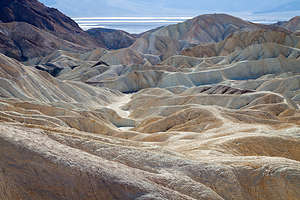 Golden Canyon TrailIn 1994, the Desert Protection Act added an additional 1.2 million acres to Death Valley National Monument and upgraded its status to National Park, making it the largest national park outside of Alaska. The park is located on the eastern border of a remote section of California with some small portions extending into Nevada. Despite its remoteness, it is one of the most highly visited parks in the national park systems. Many of these visitors come all the way from Europe and Japan to experience the extremes of this stunningly beautiful desert.
Golden Canyon TrailIn 1994, the Desert Protection Act added an additional 1.2 million acres to Death Valley National Monument and upgraded its status to National Park, making it the largest national park outside of Alaska. The park is located on the eastern border of a remote section of California with some small portions extending into Nevada. Despite its remoteness, it is one of the most highly visited parks in the national park systems. Many of these visitors come all the way from Europe and Japan to experience the extremes of this stunningly beautiful desert.
Death Valley received its name from the unfortunate forty-niners who were forced to cross the burning sands here in order to avoid the severe snowstorns in the nearby Sierra Nevada on their way to the California Gold Rush. Many perished along the way, and those that survived remembered it as a place of suffering and death. The current names of many of the places in Death Valley reflect its harshness: Dead Man Pass, Funeral Mountains, Furnace Creek, Hell’s Gate, Devil’s Golf Course, Starvation Canyon, etc.
The valley itself is over 130 miles long, but only about 12 miles wide, flanked on both sides by unvegetated reddish mountains. From an elevation of about 3,300 feet in the north, the land slopes steadily downward to an elevation of 279 feet below sea level at Badwater, the lowest point in the western hemisphere. In fact, 70 miles of the desert floor is below sea level, accounting for its extremely high termperatures, which can exceed 130°F in summer.
 Golden Canyon TrailIn many ways, not much about the valley has changed since the pioneers first crossed here. Its intense heat, frigid cold, and the driest air imaginable still make it one of the most inhospitable locations on earth. However, today’s visitors can enjoy Death Valley and see most of its highlights from the comfort of their air conditioned cars and stay in comfortable, and even luxurious, hotel rooms at night.
Golden Canyon TrailIn many ways, not much about the valley has changed since the pioneers first crossed here. Its intense heat, frigid cold, and the driest air imaginable still make it one of the most inhospitable locations on earth. However, today’s visitors can enjoy Death Valley and see most of its highlights from the comfort of their air conditioned cars and stay in comfortable, and even luxurious, hotel rooms at night.
The park is criss-crossed by a network of roads, ranging form washboard dirt ones to paved, well-maintained highways, making the most popular destinations quite accessible. The Furnace Creek Visitor Center, near the center of the park, is a great place to get oriented and to begin an exploration of Death Valley. This greenness of this area is a surprise to most visitors who come to the park expecting to see nothing but miles and miles of sand. Fed by warm springs, this area is a verdant oasis with palm trees as tall as 50 feet. There are also two world-class resorts here: the elegant Furnace Creek Inn and the more down-to-earth Furnace Creek Ranch.
Highlights traveling south from Furnace Creek on Route 190
- About 5 miles south of the Furnace Creek Visitor Center is Zabriskie Point, one of the most spectacular overlooks in the park. A short walk uphill from the parking lot brings you to a panoramic view of Golden Canyon and the surrounding vibrantly colored badlands. The views are particularly stunning in the lowlight of early morning or late afternoon.
- Another 1.5 miles down the highway s the turnout for Twenty-Mule Team Canyon road, a one-way dirt road that rejoins the highway in 2.7 miles. The road winds through Twenty-Mule Team Canyon with close-up views of the same colorful badlands seen from Zabriskie Point. RVs and trailers are not allowed on this road.
- 4.5 miles further south on 190 is a turnoff for Dante’s View (restricted to vehicles less than 25 feet). The road to Dante’s View climbs steeply to an overlook 5,000 feet above the valley floor, where the temperatures average 20° F cooler than in the valley. From this viewpoint, which most consider the most breathtaking in the park, one can see the lowest point (Badwater) and the highest point (Telescope Peak) in the park.
Highlights traveling south from Furnace Creek on Badwater Road
- About 1.8 miles south of the Visitor Center is the turnoff for Badwater Road. 1.5 miles further south on Badwater Road is the parking lot for the popular hike into Golden Canyon. A well-marked nature trail (2 miles RT) leads into the narrow canyon, wedged in by eroded cliffs and the slopes of golden badlands.
- Back on Badwater Road, continue south past Artist Drive (get that on the way back as it is a one-way road going north). Around 9 miles south of Golden Canyon is the turnoff for the unpaved spur road to Devil’s Golf Course. The road leads to an odd and forbidding landscape created by salt and erosion on a lake bed that dried up 2,000 years ago. The result is a jagged terrain of salty white miniature mountains and spires, less than 2 feet high. The name comes from the feeling that “only the devil could play golf on such rough links.”
- About 8 miles south is the Badwater Basin, the hottest and lowest point in Death Valley accessible by car. Surprisingly, its permanent spring-fed pools also make it one of the wettest. Legend says that it got its name from a surveyor whose mule refused to drink it. Although not poisonous, it is similar in composition and taste to Epsom salts. Despite its apparent inhospitableness, it is home to water beetles, insect larvae, and a soft-shelled saltwater snail that slowly adapted to these conditions.
- Turning back north on Badwater Road towards Furnace Creek, in 8 miles you come to the turnout for the one-way, 9-mile paved Artist Drive, which winds through a colorful display of sedimentary and volcanic rock hidden from the main road. It received its name from the rainbow of colors—red, pink, yellow, orange, and brown—that paint these rocky hills. About half-way through the loop is the parking lot for Artists Palette, one of the most colorful areas along the loop. Artist Drive is restricted to vehicles less than 25 feet.
Highlights traveling north from Furnace Creek on Route 190
- About 1.7 miles north of the Furnace Creek Visitor Center are the remains of what was once the Harmony Borax Works. Borax, which the prospectors called “white gold,” was once a big business in Death Valley. In the 1880s, Chinese laborers were hired to rake borax “cottonballs” from the valley floor and bring them to the Harmony Borax works to be purified. From there the refined borax was loaded onto the famous twenty-mule team wagons and transported 165 miles across the desert to the train station in Mojave. From there it was shipped to processing plants where it was used to make soaps, disinfectants, and food preservatives. Between 1883 and 1927, more than $30 million worth of borax was produced in Death Valley. A short trail leads past the ruins of the old borax refinery and some outlying buildings. More information on the mining of borax in Death Valley is available in the Borax Museum at the Furnace Creek Ranch.
- 12 miles further north on 190 is the turnoff for the 1.2 mile gravel road to Salt Creek, home to the famous Death Valley pupfish. When the lake that once covered Death Valley dried up thousands of years ago, the desert pupfish was the only fish that managed to adapt to the harsh conditions here. Isolated from each other in scattered salty pools, springs, and creeks, nine types of pupfish have evolved. A tenth has already become extinct. They are found no place else on earth. The pupfish can often be seen from the short wooden boardwalk nature trail that crisscrosses the stream and marshes.
- About 21 miles north of the Visitor Center, Highway 190 turns west towards Stovepipe Wells and the west entrance to the park. At this point, you can either continue on 190 or head north on the North Highway another 32 miles to Scotty’s Castle, the major man-made attraction in Death Valley.
Highlights along the North Highway (traveling north)
- The drive to Scotty’s Castle on the North Highway is a very scenic one with desert stretching out on the west and mountains rising to the east. About 10 miles north on the North Highway is a pullout with great views of Death Valley’s renowned alluvial fans. These fans are something like an hourglass with debris from the mountains funneling through a narrow opening and spilling out in a wedge shape into the valley. They come in many shapes and sizes. The ones near this viewpoint are smaller and steeper.
- 25 miles further north in the remote Grapevine Canyon looms the unlikely sight of a Moorish Castle. Construction of what was more officially called Death Valley Ranch was begun in 1922 by Chicago millionaire Albert Johnson, whose doctors had advised him to spend more time in a warm, dry climate. However, the mansion is known as Scotty’s Castle, named after Johnson’s unlikely friend, Walter Scott. Walter Scott was a cowboy that had traveled with Buffalo Bill’s Wild West Show in the 1880s before taking up prospecting. Albert Johnson was one of Scotty’s gullible investors in his “secret gold mine” in Death Valley. After several trips west to see the mine, Johnson realized that he was being duped by Scotty. Despite that, Johnson truly enjoyed his new friend and the tall tales he told. Scotty helped Johnson conceive the idea of this vacation villa in Death Valley and lived in it after Johnson’s death.
- In 1970, Scotty’s Castle was purchased by the National Park Service from the foundation to whom Johnson had willed it. Today the colorful history of the castle is brought to life by rangers dressed in 1930s clothing that welcome you as if you were Scotty’s guests. The one-hour guided tour is excellent, both for its inside look at this unusual mansion as well as for the stories about the eccentricities of the two men that built it. Tours depart every 20 minutes from 9 am to 5 pm. Plan to arrive early because they fill up quickly.
- About 1.5 miles down Grapevine Canyon heading back south on the North Highway is the turnoff for the 8 mile road to Ubehebe Crater. This half-mile wide, 600-foot deep crater was formed by volcanic explosions several thousand years ago. Dark cinders and volcanic fragments cover the surrounding countryside. From the parking area there is a steep trail up to the crater’s rim. Be prepared to battle some very gusty winds.
- Because of its remote location, few visitors get to see the famous Death Valley Racetrack, where rocks mysteriously move across the dry lakebed on their own accord. Although no one has actually seen the rocks move, they are known to move because of the trails they leave behind them. After studying the phenomenon for decades, scientists now believe they have solved the mystery. The surface of the lakebed is a fine clay that becomes very slippery when wet. After a rain, heavy winds as high as 70 mph blow the rocks across the slick surface. A 4-wheel drive vehicle is needed to reach the Racetrack, which is 27 miles past Ubehebe Crater on a rough dirt road.
Highlights traveling west along Route 190 from the junction with the North Highway
- Just west of the junction is the parking area for the surrealistic Devil’s Cornfield. On both sides of the road are odd-looking clumps of brush four to ten feet tall that resemble corn stalks. They are actually arrowweed bushes, whose stems were used by Native Americans to make arrow shafts.
- A few miles further west on 190, pull over on the shoulder by a roadside display where the Sand Dunes come close to the highway. These are the highest of a 14-square-mile field of dunes. Although there are no trails to follow, hikers are free to roam the dunes on their own. The best time of day to visit the dunes is in the morning or late afternoon when the temperatures are cooler and the lighting is more dramatic.
- Two miles further west is the village of Stovepipe Wells, Death Valley’s first tourist resort. The village actually got its name from an historic site about 5 miles north where an old stovepipe was sunk into the sand to form the shaft of a well. For years this well was used by travelers as a source for water. Around 1926 a developer planned to build a small resort near the well. However, his lumber trucks got stuck in the sand before he could reach it. Rather than unload and reload his trucks, he decided to try and dig a well where they were. They struck water and stayed. That spot is the current location for Stovepipe Wells. Today the village has a motel, general store, saloon, restaurant, and campground.
Campgrounds that will accomodate RVs in Death Valley
- Furnace Creek Campground (136 sites, no hookups) – located just north of the Visitor Center. Open year round. This is the only park campground that takes reservations.
- Mesquite Spring Campground (30 sites, no hookups) – located 5 miles south of Scotty’s Castle. Open year round.
- Panamint Springs Resort (40 sites, 12 hookups) – located 30 miles west of Stovepipe Wells on Route 190. Open year round. This campground is privately operated and takes reservations.
- Stovepipe Wells Campground (200 sites, 15 hookups) – located in the village of Stovepipe Wells. Open year round.
- Sunset Campground (1000 sites, no hookups) – located .25 miles east of the Furnace Creek Ranch. Open October through April.
- Texas Spring Campground (92 sites, no hookups) – located near Sunset Campground. Open October through April.
- Wildrose Campground (30 sites, no hookups) – located 30 miles south of Stovepipe Wells off the Trona-Wildrose Road. Open year round.
In addition to the park campgrounds, there are two privately-owned campgrounds in the park:
- Furnace Creek Ranch Campground (26 sites, all full hookups) - located at The Ranch just south of the Visitor Center. Open year round. Guests can enjoy the Ranch’s natural spring-fed swimming pool, shower facility, coin operated laundry, tennis courts, shuffleboard, volleyball, Bocci Ball and basketball court.
- Panamint Springs Campground (37 sites, 12 full hookups) - located at the western end of Death Valley National Park on Highway 190 in the town of Panamint Springs
Trona Pinnacles
Friday, April 5, 2019 - 4:15pm by Lolo111 miles and 2.25 hours from our last stop - 1 night stay
Travelogue
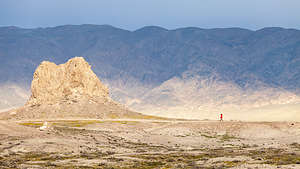 Lolo approaching a large pinnacleHerb had been to Trona Pinnacles on a solo trip last year and had ever since been anxious to bring me there to see its uniqueness and stark beauty. I think it was pretty sweet that he wanted to share his experience with me.
Lolo approaching a large pinnacleHerb had been to Trona Pinnacles on a solo trip last year and had ever since been anxious to bring me there to see its uniqueness and stark beauty. I think it was pretty sweet that he wanted to share his experience with me.
It is pretty much out in the middle of nowhere, 20 miles from the nearest town and reached via a 5-mile, BLM dirt road that leads you to a lunar-like landscape of more than 500 tufa spires, of varying shapes and sizes, some as high as 140 feet, rising from the bed of the Searles Dry Lake basin.
Like the Mono Lake tufa towers, another one of Herb’s favorite barren and desolate otherworldly spots, the crumbling towers around us were also made of calcium carbonate and had been formed thousands of years ago underwater. Now with the lake long dried up, they sit isolated, surrounded by miles of dried mud and mountain ranges.
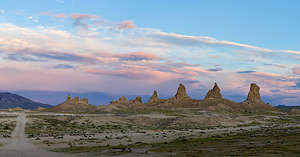 Golden hour at Trona PinnaclesAs I mentioned in the previous stop, there couldn’t have been a starker contrast between the landscape and experience of being at of Trona Pinnacles and that of Antelope Valley - desolate vs. crowded, sharp rocky spires vs gente rolling hills, monochromatic grays and browns vs. the vibrant hues of the flowers. It is these differences that makes each of these places more special, and travel more interesting.
Golden hour at Trona PinnaclesAs I mentioned in the previous stop, there couldn’t have been a starker contrast between the landscape and experience of being at of Trona Pinnacles and that of Antelope Valley - desolate vs. crowded, sharp rocky spires vs gente rolling hills, monochromatic grays and browns vs. the vibrant hues of the flowers. It is these differences that makes each of these places more special, and travel more interesting.
Dispersed camping is allowed in designated areas at the Pinnacles, and there is a pit toilet. Other than that there’s just sand and rocks.
When we arrived, we were the only ones there, so we had our choice of campsites - and I use the term “campsite” loosely. Herb decided to position ourselves where we would get the best view of the spires in the evening light.
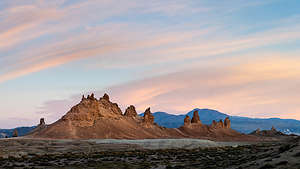 Golden hour at Trona PinnaclesAlthough the landscape was interesting and photogenic during the day, it really came into its own when the sun began to set behind us, lighting up the ski behind the spires in fabulous pastel pinks and blues..
Golden hour at Trona PinnaclesAlthough the landscape was interesting and photogenic during the day, it really came into its own when the sun began to set behind us, lighting up the ski behind the spires in fabulous pastel pinks and blues..
Being the good photo assistant I am, I made the trek across the dried mud to the spires, wearing my bright red jacket, so Herb could get an object in his photos (that’s me) to give a sense of scale. Some of the best photos of me are tiny little dots in a beautiful landscape.
The next morning our spires were silhouetted against the rising sun, but the rocks behind us were now lit up underneath another beautiful pink and blue sky.
Great stop, but really only a one-nighter, so on to Death Valley!
Description
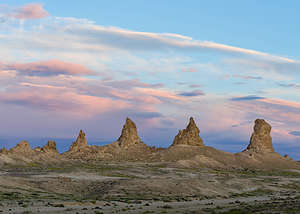 Golden hour at Trona PinnaclesThe Trona Pinnacles are a unique geological formation in the California Desert National Conservation Area, approximately 20 miles east of the town of Ridgecrest, California. Getting there requires driving along a 5-mile, BLM dirt road (RM143) that is usually accessible in a 2WD vehicle.
Golden hour at Trona PinnaclesThe Trona Pinnacles are a unique geological formation in the California Desert National Conservation Area, approximately 20 miles east of the town of Ridgecrest, California. Getting there requires driving along a 5-mile, BLM dirt road (RM143) that is usually accessible in a 2WD vehicle.
The lunar-like landscape consists of more than 500 tufa (calcium carbonate) spires, of varying shapes and sizes, some as high as 140 feet, rising from the bed of the Searles Dry Lake basin. Once underwater thousands of years ago, the crumbling towers now sit isolated, surrounded by miles of dried mud and stark mountain ranges.
The pinnacles are classified into four general shapes:
- Towers - 30 to 40 feet high with pointed, rounded, or flat summits
- Tombstones - 20 to 30 feet high and more stubby and squat
- Cones - less than 10 feet high
- Ridges - massive, toothy, and tufa runs. One ridge in Trona is 800 feet long, 500 feet wide and 140 feet tall.
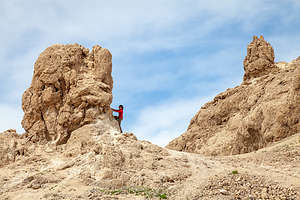 Lolo playing on Trona PinnaclesThe best time to view and photograph the pinnacles is at sunrise or sunset.
Lolo playing on Trona PinnaclesThe best time to view and photograph the pinnacles is at sunrise or sunset.
Over 30 movies, TV shows, and commercials were filmed in this start and eerie setting, including Lost in Space, Planet of the Apes, and Star Trek V.
As with most BLM land, there is free dispersed camping in designated areas and a pit toilet.
Antelope Valley Poppy Reserve
Friday, April 5, 2019 - 4:00pm by Lolo114 miles and 2.5 hours from our last stop
Travelogue
 Antelope Valley Poppy ReserveThe next stop on our super bloom tour of southern California brought us to the amazing Antelope Valley California Poppy Reserve, located a bit too close to L.A. (just an hour and a half) to expect the serenity we had experienced in Carrizo Plains.
Antelope Valley Poppy ReserveThe next stop on our super bloom tour of southern California brought us to the amazing Antelope Valley California Poppy Reserve, located a bit too close to L.A. (just an hour and a half) to expect the serenity we had experienced in Carrizo Plains.
Fortunately, we were not arriving on a weekend, when crowds as large as 60,000 descend upon this lovely 1,700-acre Reserve. We got there around 9:00 am on a Friday morning, driving right past the sign, “1 hour wait from here,” paid our $9 parking fee ($10 for non-seniors, so bring an old person), and easily found parking in the fairly large lot.
To quote Julie Andrews, “The hills were alive…” - but with dazzling color rather than the sound of music. The brilliant orange of the California poppies dominated the hillsides, intermixed with the bright golden yellow of Goldfields and the deep lush purples of lupines. It truly was amazing.
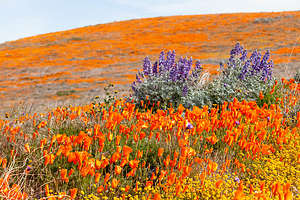 Antelope Valley Poppy ReserveThere are eight miles of walking trails that wind their way along the flower-covered hills. We hiked about 5 miles of them before deciding to relinquish our parking space and give someone else a chance.
Antelope Valley Poppy ReserveThere are eight miles of walking trails that wind their way along the flower-covered hills. We hiked about 5 miles of them before deciding to relinquish our parking space and give someone else a chance.
This was a particularly good bloom because of all the rain. It started in mid-February and is expected to last through May. You can find out the current bloom status and what flowers are expected along each trail by calling the hotline at 661-724-1180.
I highly recommend it.
After leaving the Reserve, we drove back a short distance to a spot alongside the road where there were Joshua Trees surrounded by bright yellow flowers, a lovely juxtaposition
Now it was on to Trona Pinnacles, a place that couldn’t be more opposite from the crowded, colorful, rolling hills of Antelope Valley.
Description
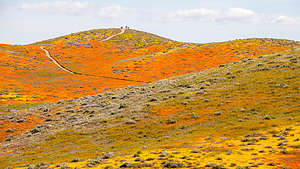 Antelope Valley Poppy ReserveAntelope Valley California Poppy Reserve is a 1,700-acre park famous for its springtime poppy-blanketed hills. The Reserve is located about an hour and a half north of Los Angeles along the western edge of the Mojave Desert grasslands.
Antelope Valley Poppy ReserveAntelope Valley California Poppy Reserve is a 1,700-acre park famous for its springtime poppy-blanketed hills. The Reserve is located about an hour and a half north of Los Angeles along the western edge of the Mojave Desert grasslands.
After winters where there has been sufficient rainfall, the hills of the Reserve come alive with brilliant oranges (California poppies), yellows (goldfields), and purples (lupine). The duration and intensity of the colors vary from year to year and generally lasts from mid-February through May.
The Reserve has eight miles of walking trails along the gentle, flower-covered, rolling hills. There is a paved section for wheelchair access.
To find out the current bloom status and what flowers you can expect to find along each trail, call the hotline at 661-724-1180.
There is a $10 per vehicle parking fee ($9 for seniors).
Carrizo Plains National Monument
Wednesday, April 3, 2019 - 3:30pm by Lolo327 miles and 6 hours from our last stop - 2 night stay
Travelogue
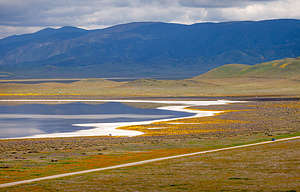 Carrizo Plains - Soda Lake salt flatsThey say every cloud (no pun intended) has a silver lining, and our consolation for weeks and weeks of seemingly endless rain was the promise of a spectacular super bloom in southern California.
Carrizo Plains - Soda Lake salt flatsThey say every cloud (no pun intended) has a silver lining, and our consolation for weeks and weeks of seemingly endless rain was the promise of a spectacular super bloom in southern California.
We never had super blooms in New Jersey, as it is a desert phenomena that only occurs after a particularly rainy winter season - and we had neither deserts or rainy seasons in NJ - so we were very anxious to experience one. Our weather forecast wasn’t particularly inspiring, but we decided to head out anyway, as it was a Wednesday, and we wanted to beat the hoards of fellow super bloomers that descend upon these parks on weekends, causing traffic jams and general crankiness - Herb hates traffic.
The drive to Carrizo Plains National Monument was about 5 and ½ hours, most of it along 101, where the hills and vineyards along the way were a brilliant vibrant green - its version of a super bloom.
 Carrizo Plains - Soda Lake salt flatsWe got off 101 onto Route 58 in the lovely town of Paso Robles, the last major town before the northern entrance to Carrizo Plains, about 50 miles away. About 5 miles past the town, we realized there would be no gas stations before Carrizo, so we made a quick U-Turn and filled up.
Carrizo Plains - Soda Lake salt flatsWe got off 101 onto Route 58 in the lovely town of Paso Robles, the last major town before the northern entrance to Carrizo Plains, about 50 miles away. About 5 miles past the town, we realized there would be no gas stations before Carrizo, so we made a quick U-Turn and filled up.
As we were driving along Route 58, we stopped alongside the road, with about a dozen other cars, to photograph a spectacular field of bright yellow flowers. I am sorry to say I am not a botanist, so colors are about as descriptive as I’m going to get. If this was any indication of what we would encounter when we actually reached Carrizo, this was going to be great.
We arrived in Carrizo Plains by mid-afternoon, with plenty of daylight hours left to explore. There are really only two roads through Carrizo that pretty much run parallel to each other for about 40 miles from the north to the south ends of the park.
 Herb doing what he loves doingSoda Lake Road runs down the middle of the park, and as you would expect, runs alongside its namesake, Soda Lake. The northern part of Soda Lake Road is paved, but in the south it is dirt. In fact, all other roads in the park are dirt, which, as the park brochure warns, become muddy and impassable during periods of rain - a reality that we were unfortunately going to learn about first hand on Day 2.
Herb doing what he loves doingSoda Lake Road runs down the middle of the park, and as you would expect, runs alongside its namesake, Soda Lake. The northern part of Soda Lake Road is paved, but in the south it is dirt. In fact, all other roads in the park are dirt, which, as the park brochure warns, become muddy and impassable during periods of rain - a reality that we were unfortunately going to learn about first hand on Day 2.
Elkhorn Road, which is reached via several crossroads from Soda Lake Road, runs alongside the foothills of the Temblor Range, on the eastern boundary of the park.
There are tons of smaller dirt roads leading off these two main roads, most of them leading up into the foothills on either side (the Caliente Range in the West and the Temblor Range in the East). It is along these roads up in the foothills where dispersed free camping is allowed. There are also two official campgrounds that have pit toilets. I pointed that out to Herb, but he was having none of that - we were camping in the foothills.
 Little lolo loose in Carizzo PlainsWe entered the park on the Soda Lakes Road, and after about 3 miles came to the actual Soda Lake, which was actually a lake now, rather than the dry lake bed it is for much of the year. To get a good overall view of it, we drove to the top of Overlook Hill, where there was an expansive view of the lake, the entire Carrizo Plain, and the foothills of the Temblor Range, blanketed in wildflowers, painting them in brilliant yellows and purples
Little lolo loose in Carizzo PlainsWe entered the park on the Soda Lakes Road, and after about 3 miles came to the actual Soda Lake, which was actually a lake now, rather than the dry lake bed it is for much of the year. To get a good overall view of it, we drove to the top of Overlook Hill, where there was an expansive view of the lake, the entire Carrizo Plain, and the foothills of the Temblor Range, blanketed in wildflowers, painting them in brilliant yellows and purples
This view is very different most of the year, when the lake dries up and becomes an expansive salt flat.This occurs because Soda Lake is a closed basin, with no inlets or outlets, so when water trickles down from the mountains into the lake during the winter and then evaporates in spring, it leaves behind a glistening expanse of sulfate and carbonate salts, making it the largest remaining natural alkali wetland in southern California.
Down at lake level again, we stopped to walk along the interpretative boardwalk trail that runs alongside the lake.
 Our camping spot in the Temblor Range foothillsHowever, Herb was anxious to find a home in the foothills for the night, so we got back in the 4Runner, drove to the southern end of the lake and took a left on Simmler Road, which brought us across to Elkhorn Road and its many offshoots up into the Temblor Range foothills, which were painted in vibrant yellow and a more subdued purple. I believe the yellow were goldfields and the purples were lupines, but whatever they were, they were spectacular.
Our camping spot in the Temblor Range foothillsHowever, Herb was anxious to find a home in the foothills for the night, so we got back in the 4Runner, drove to the southern end of the lake and took a left on Simmler Road, which brought us across to Elkhorn Road and its many offshoots up into the Temblor Range foothills, which were painted in vibrant yellow and a more subdued purple. I believe the yellow were goldfields and the purples were lupines, but whatever they were, they were spectacular.
We spent a lovely evening strolling along the base of the foothills, photographing their splendor.
Dispersed camping in the wild is such a serene and tranquil experience that is truly rejuvenating for the soul. Herb loves everything about it, and I do too, with one minor exception - the 2 inch clearance between my slumbering nose and the roof of the 4Runner when sleeping on the platform bed Herb built in the back. There really was no other design choice if we wanted the storage space for a large cooler and gear below, so I am learning to live with it. However, I did have one cranky attack when trying to remove my jacket, which I had fallen asleep in. I felt like Houdini trying to escape from a straight jacket.
 Carrizo Plains - Soda Lake salt flatsThe next morning, after completing our domestic and personal duties, we headed back down to Elkhorn Road to the parking lot for the Wallace Creek Interpretive Trail for a closeup view of the Andreas Fault, which runs along the northeast side of Carrizo Plain, and the chance to be on two different tectonic plates (the Pacific and North American) in one hike.
Carrizo Plains - Soda Lake salt flatsThe next morning, after completing our domestic and personal duties, we headed back down to Elkhorn Road to the parking lot for the Wallace Creek Interpretive Trail for a closeup view of the Andreas Fault, which runs along the northeast side of Carrizo Plain, and the chance to be on two different tectonic plates (the Pacific and North American) in one hike.
This area is considered to be one of the most important geological sites in the world in that you can see first hand the effects of plate tectonics. In fact, the Carrizo Plain owes its very existence to the geologic processes that occur along the San Andreas Fault. 30 million years ago, movement along the San Andreas and San Juan fault lines caused the rise of the Temblor and Caliente mountain ranges on either side of the valley, and the formation of the shallow basin in between now known as Soda Lake.
While it’s a little tough to wrap your head around and visualize how earthquakes can create entire mountain ranges, it is a bit easier to absorb how the movement of plates along a fault line can cause a creek to shift and bend. That is exactly what we would see along this trail.
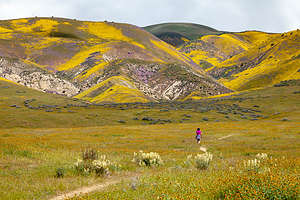 Wallace Creek Interpretive TrailWe followed the trail along the fault, before climbing up a steep ridge overlooking the dry creek bed, which is sometimes Wallace Creek. Unlike most creeks that meander and gently curve, this one has two almost 90-degree bends, which were caused by a 7.9-magnitude earthquake in 1857, in which the Pacific plate moved 30 feet past the North American plate. The Andreas Fault crosses Wallace Creek almost exactly through these two tight bends.
Wallace Creek Interpretive TrailWe followed the trail along the fault, before climbing up a steep ridge overlooking the dry creek bed, which is sometimes Wallace Creek. Unlike most creeks that meander and gently curve, this one has two almost 90-degree bends, which were caused by a 7.9-magnitude earthquake in 1857, in which the Pacific plate moved 30 feet past the North American plate. The Andreas Fault crosses Wallace Creek almost exactly through these two tight bends.
The Andreas fault cuts crosses the Carrizo Plain from northwest to southeast. Everything southwest of the fault, including the Caliente Range and the downstream half of Wallace Creek, is on the Pacific plate and sliding slowly to the northwest (toward San Francisco) while everything that lies northeast of the fault, including the Temblor Range and the upstream half of Wallace Creek, is on the North American plate sliding to the southeast (toward Los Angeles). Unlike the 30-foot jump of the plates in 1857, the usual rate of movement is an imperceptible 1.3 inches per year.
I wanted to make sure I was on the same tectonic plate as Herb at all times in case anything happened.
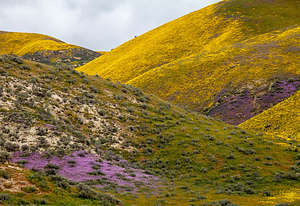 The colored hills of Carrizo PlainsAfter our very educational hike, we headed over to the Pacific Plate section of the park - just showing off my new knowledge - with the plan of exploring and finding camping in the foothills of the Caliente Range. We took a few side dirt roads off of Soda Lake Road, which was also now dirt, to look for remnants of old ranches as well as potential camping spots for the night.
The colored hills of Carrizo PlainsAfter our very educational hike, we headed over to the Pacific Plate section of the park - just showing off my new knowledge - with the plan of exploring and finding camping in the foothills of the Caliente Range. We took a few side dirt roads off of Soda Lake Road, which was also now dirt, to look for remnants of old ranches as well as potential camping spots for the night.
Unfortunately, the weather was beginning to turn for the worse, but the clouds sure were interesting. Soon it began to drizzle, and what had been perfectly drivable roads before, turned into slippery mud. On our way back down to Soda Lake Road from one of the offshoots, we actually spun around 270 degrees. Since the weather didn’t look like it would be improving any time soon, we decided, for safety reasons, to leave the park tonight and find a motel to stay in.
Easier said than done. We decided to cross back over to Elkhorn Road, with the intention of leaving Carrizo out the south entrance along the Elkhorn Grade Road. The better choice would have been to stay on Soda Lake Road to the paved Route 166. Hindsight is always great.
The crossover to Elkhorn involved going up and down a small mountain, during which we spun around once more. When we finally got to Elkhorn Grade Road, we saw that it too was dirt, or more correctly slippery mud. We made it about 20 feet slipping and sliding before turning around and heading back towards the north entrance (40 miles away).
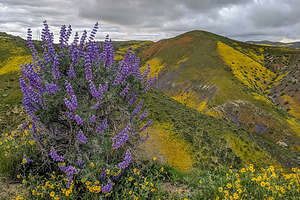 Along Hurricane Ridge RoadElkhorn Road was flat, so it was a bit better, but we still did one more almost 360. Finally, the road got a little better as it had rained less in the northern part of the park. Rather than go the entire length to the northern exit, we turned right onto Hurricane Ridge Road, which would bring us out to Route 33. The road was steep, narrow, and twisty, but highly scenic. If it had been wet, it would have been a nightmare.
Along Hurricane Ridge RoadElkhorn Road was flat, so it was a bit better, but we still did one more almost 360. Finally, the road got a little better as it had rained less in the northern part of the park. Rather than go the entire length to the northern exit, we turned right onto Hurricane Ridge Road, which would bring us out to Route 33. The road was steep, narrow, and twisty, but highly scenic. If it had been wet, it would have been a nightmare.
Finally, we reached the less than scenic town of Taft, where there were oil pumpjacks (also appropriately called nodding donkeys) pumping as far as the eye could see. What a contrast to the serenity and natural beauty of Carrizo Plains.
We drove about an hour more to a Days Inn in the town of Lebec.
Description
 Carrizo Plains - Soda Lake salt flatsCarrizo Plains National Monument, located about 100 miles northwest of Los Angeles and 60 miles east of San Luis Obispo, is one of the best kept secrets in California.
Carrizo Plains - Soda Lake salt flatsCarrizo Plains National Monument, located about 100 miles northwest of Los Angeles and 60 miles east of San Luis Obispo, is one of the best kept secrets in California.
Since the mid-1800s, large portions of the grasslands of the 400-mile long San Joaquin Valley have disappeared as a result of urban and agricultural development.The Carrizo Plain National Monument is the largest remaining undeveloped remnant of that once vast ecosystem, offering a refuge for many endemic plant and animal species.
The Carrizo Plain owes its existence to the geologic processes that occur along the San Andreas Fault, which runs along the northeast side of the plain. 30 million years ago, movement along the San Andreas and San Juan fault lines caused the rise of the Temblor and Caliente mountain ranges on either side of the valley, and the formation of the shallow basin in between now known as Soda Lake.
Soda Lake is a closed basin, so when water trickles down from the mountains into the lake during the winter and then evaporates in spring, it leaves behind a glistening expanse of sulfate and carbonate salts, making it the largest remaining natural alkali wetland in southern California. During the heat of the summer, the salt flat appears to ripple and sway.
The lake can be viewed either by climbing to the top of a small hill above the lake or by strolling along a boardwalk alongside it that crosses the wetlands to a vista point.
 Lolo of CarrizoThe Wallace Creek Interpretive Trail, on the opposite side of the lake, provides as closeup view of the San Andreas Fault and is one of the most important geological sites in the world in that you can see the effects of plate tectonics first hand. The trail runs diagonally along the fault and then makes a steep climb to a ridge overlooking two almost 90-degree bends in the dry creek bed, caused by the slippage of the San Andreas Fault, most recently by a 7.9-magnitude earthquake in 1857.
Lolo of CarrizoThe Wallace Creek Interpretive Trail, on the opposite side of the lake, provides as closeup view of the San Andreas Fault and is one of the most important geological sites in the world in that you can see the effects of plate tectonics first hand. The trail runs diagonally along the fault and then makes a steep climb to a ridge overlooking two almost 90-degree bends in the dry creek bed, caused by the slippage of the San Andreas Fault, most recently by a 7.9-magnitude earthquake in 1857.
In spring, if conditions are right, a super bloom occurs, and numerous wildflowers carpet the valley floor and the foothills of the Temblor and Caliente mountains, painting them in breathtaking bright yellows and purples. Expect large crowds on weekends.
The Carrizo Plains National Monument can be reached from the north via State Route 58 or from the South via State Route 33/166. There are no services in the park, so be sure to gas and stock up in one of the gateway communities outside the park.
There are two developed campgrounds in the Monument as well as dispersed camping along the foothills.

